Agitators
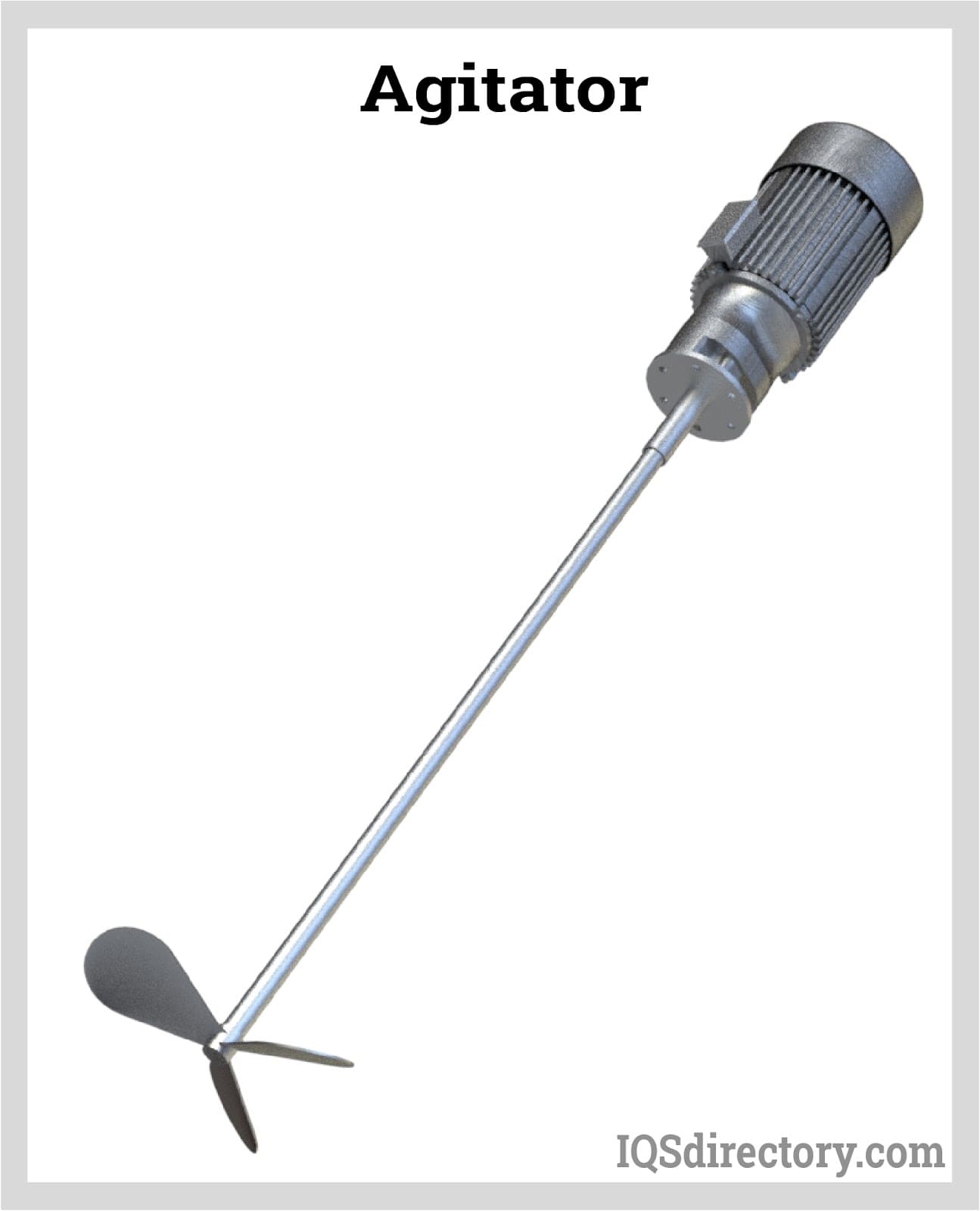
Agitators are equipment used in homogenizing media inside a tank. It works by rotating the impeller at its immersed end at a controlled speed or revolutions per minute (rpm). The work exerted by...
Please fill out the following form to submit a Request for Quote to any of the following companies listed on
This article has everything you will want to know about industrial blenders and their use.
You will learn:

An industrial blender is a large-scale equipment specifically designed to mix and unify diverse manufacturing materials within a sizable containment. These devices are prized for their capability to effectively blend materials and facilitate reactions between them, making them ideal for a vast array of industrial purposes. Their significant capacity and cost-efficient operation are primary factors in their widespread use in various mixing processes.
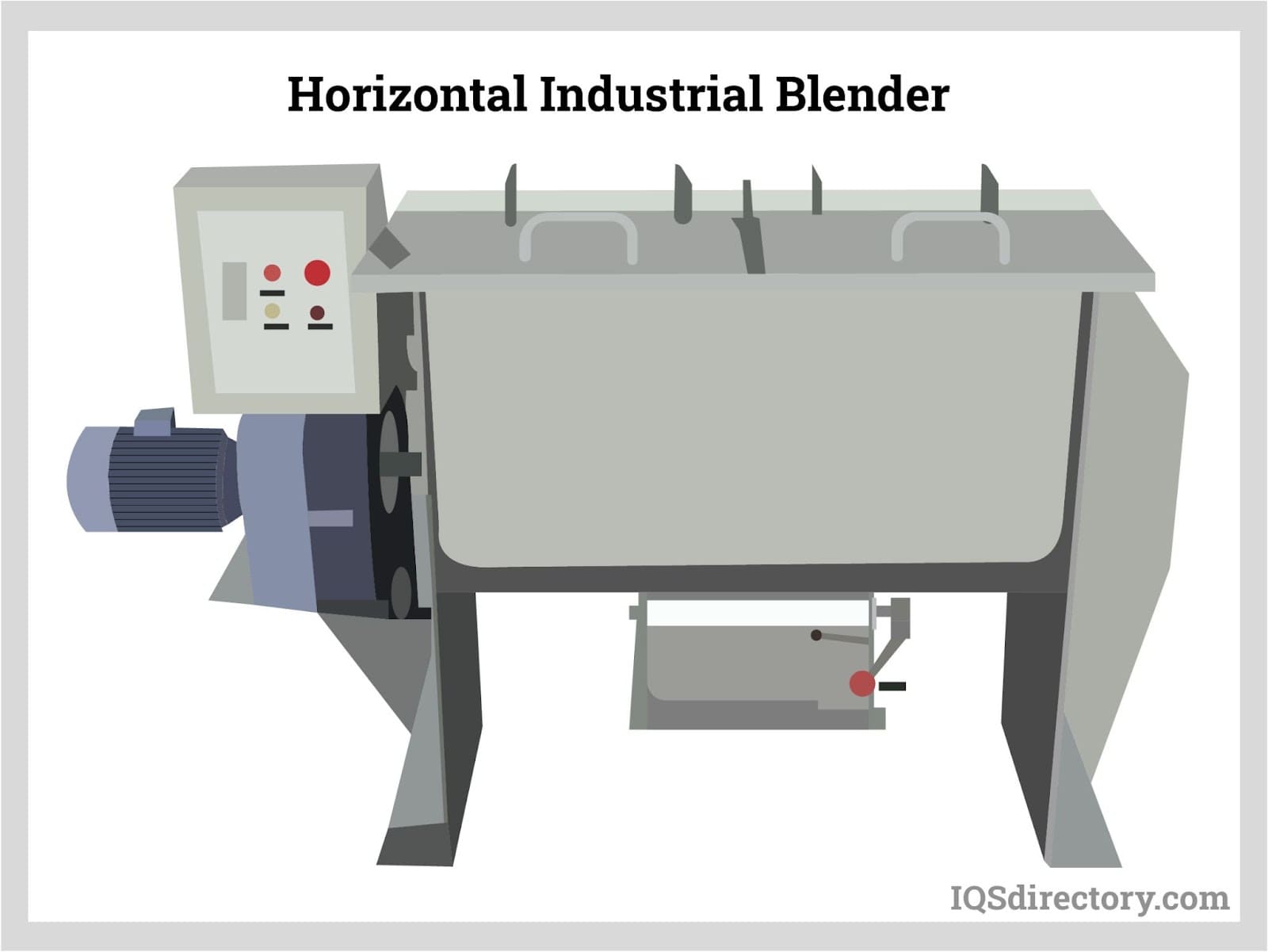
Industrial blenders are frequently employed in scientific applications that necessitate the precise mixing of chemicals and pharmaceuticals. Their competence in providing exact measurements and uniform results makes them indispensable for accurately combining substances, often utilizing advanced PLC programming to modulate the mixing process.
Considering their usage, blenders are generally manufactured from stainless steel. Nevertheless, in scenarios where stringent sanitation is not essential, they can also be produced using materials such as steel, cast iron, or aluminum.
A diverse range of industrial blenders is available, each tailored and crafted to suit specific industrial mixing applications. These industrial blenders and mixers are capable of blending a wide variety of materials, including solids, liquids, powders, granules, viscous pastes, abrasive substances, and even stones. Choosing the most suitable industrial blender can greatly impact process efficiency, production consistency, and product quality across numerous industries such as food processing, pharmaceuticals, chemicals, construction, plastics, and cosmetics.
Selecting the right industrial blender is crucial to ensuring it is well-suited for the specific materials being processed and meets industry requirements for scale, consistency, and throughput. With a broad spectrum of industrial blender types and designs available, from batch blenders to continuous mixing systems, finding an industrial blender that perfectly aligns with the requirements of a particular industrial task—whether it involves dry mixing, liquid blending, dispersion, emulsification, or homogenization—is achievable with a careful evaluation of process needs and desired blending outcomes.
Agitator industrial blenders offer continuous mixing for liquids through constant motion. This method relies on non-specific movements to blend materials, using rotating paddles or impellers for fluid agitation. While they are primarily designed for low-viscosity materials, such as liquid solutions or light slurries, they can be adapted with sturdier paddles or upgraded motor power to handle high-viscosity substances and more demanding industrial mixing processes effectively. Agitator blenders are commonly found in food processing, beverage, paint, and chemical manufacturing environments where uniform liquid mixing is required.
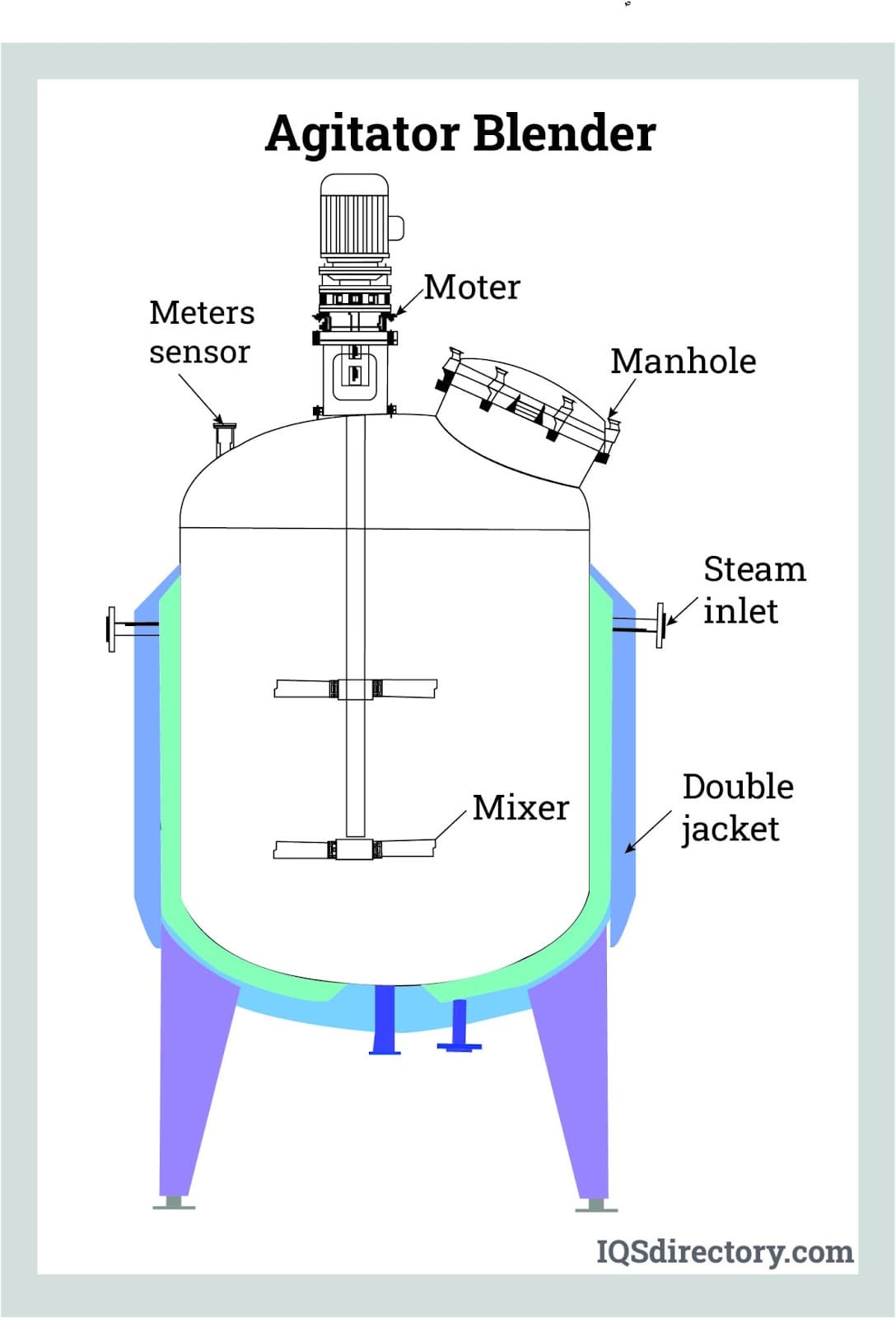
A paddle mixer is a form of agitator, specifically designed for the blending of dry bulk materials and powders. Paddle blenders are used for gentle applications such as coating nuts, blending salads, mixing pharmaceutical powders, or creating wet slurries for food or chemical processes. They can also be engineered for thermal applications, such as cooking and blending simultaneously. The sizes of paddle blenders vary between 5 cu ft and 500 cu ft, offering flexibility for both small-batch and large-scale industrial mixing.
A paddle blender operates with paddles affixed to a central shaft, which stir the materials in a tumbling or folding action to ensure thorough and gentle mixing. These blenders may feature a discharge valve at the base or a tilting mechanism to release the blended contents, optimizing batch changeover and reducing waste. They operate at slower speeds to protect particle integrity and ensure a uniform and consistent mixture, making them suitable for industries like food processing, nutraceuticals, chemicals, and animal feed production.
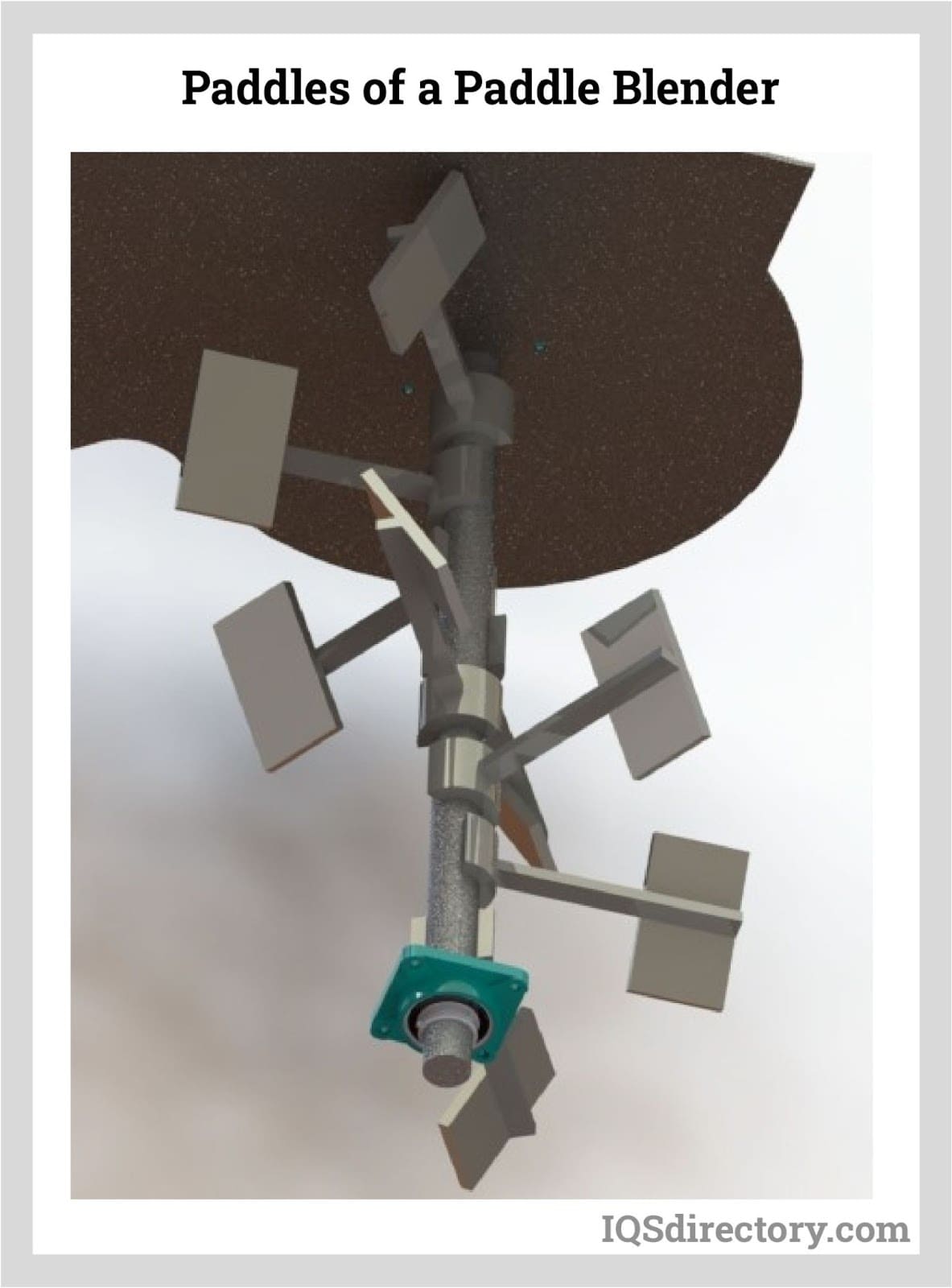
The purpose of an emulsifier is to mix immiscible substances that are resistant to being mixed, such as water and oil. The emulsification process applies pressure to the substances, forcing them through filters or perforated plates to break down the molecular structure of the materials such that large molecules are made smaller and can combine more effectively. Emulsifier blenders are essential for producing stable emulsions in products like mayonnaise, creams, lotions, dressings, and industrial chemical formulations.
To improve the blending process of tougher or heterogeneous materials, an emulsifying agent can be introduced into the mixture. Unlike traditional blenders with blades, emulsifiers utilize specialized mixing chambers, high-shear heads, or pipelines through which the materials pass, allowing them to pre-mix and rapidly achieve a uniform, smooth consistency before the actual blending occurs. Industries such as cosmetics, pharmaceuticals, food, and chemical processing depend on industrial emulsifier mixers for product stability and quality.
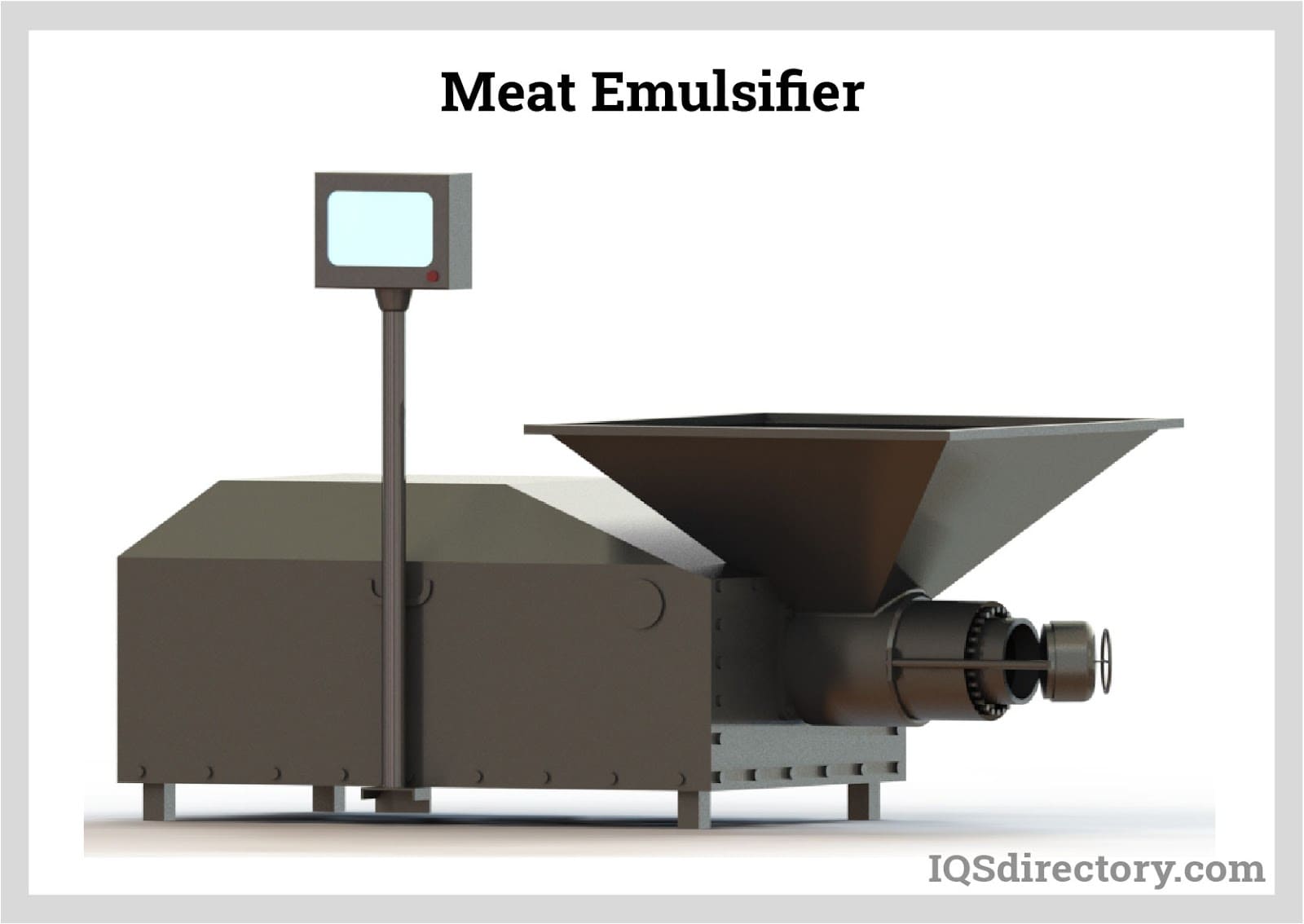
Dual shaft blenders feature two adjacent tubs, each containing a centrally positioned shaft. The shafts may be powered by a single motor using a crossover drive or by separate motors for each shaft. These shafts can rotate in various directions—parallel, opposing, or reversing. Depending on their spacing, the shafts can be positioned close enough to draw material from one another or set farther apart to avoid contact.
With dual motors, a dual shaft blender can operate the shafts at different speeds or in opposite directions, offering versatile industrial mixing capabilities. These blenders can be equipped with either ribbon or blade mixing elements, similar to those used in other commercial blender models. Dual shaft blenders are highly valued in processing applications that require thorough dispersion and uniformity of high-viscosity materials, adhesives, and pastes.
Ribbon blenders feature elongated, ribbon-shaped blades designed for mixing solid materials. These blades rotate around a central axis, and their distinctive ribbon-like shape is where the blender gets its name. Ribbon blenders are particularly effective at breaking up lumps in liquids that have been stored for a period.
The helical mixing tool, which occupies the entire mixing shaft, generates a spiral flow within the mixing chamber. Ribbon blenders are versatile, capable of mixing a range of materials such as powders, pellets, flakes, granules, pastes, slurries, and dough. The spiral motion of the helical blades produces a three-dimensional flow pattern, with material moving upward along the outer edges and downward in the center. Industries such as food, pharmaceuticals, chemicals, and plastics use ribbon blenders for dry blending, rehydration, and batch processing due to their high efficiency and scalability.
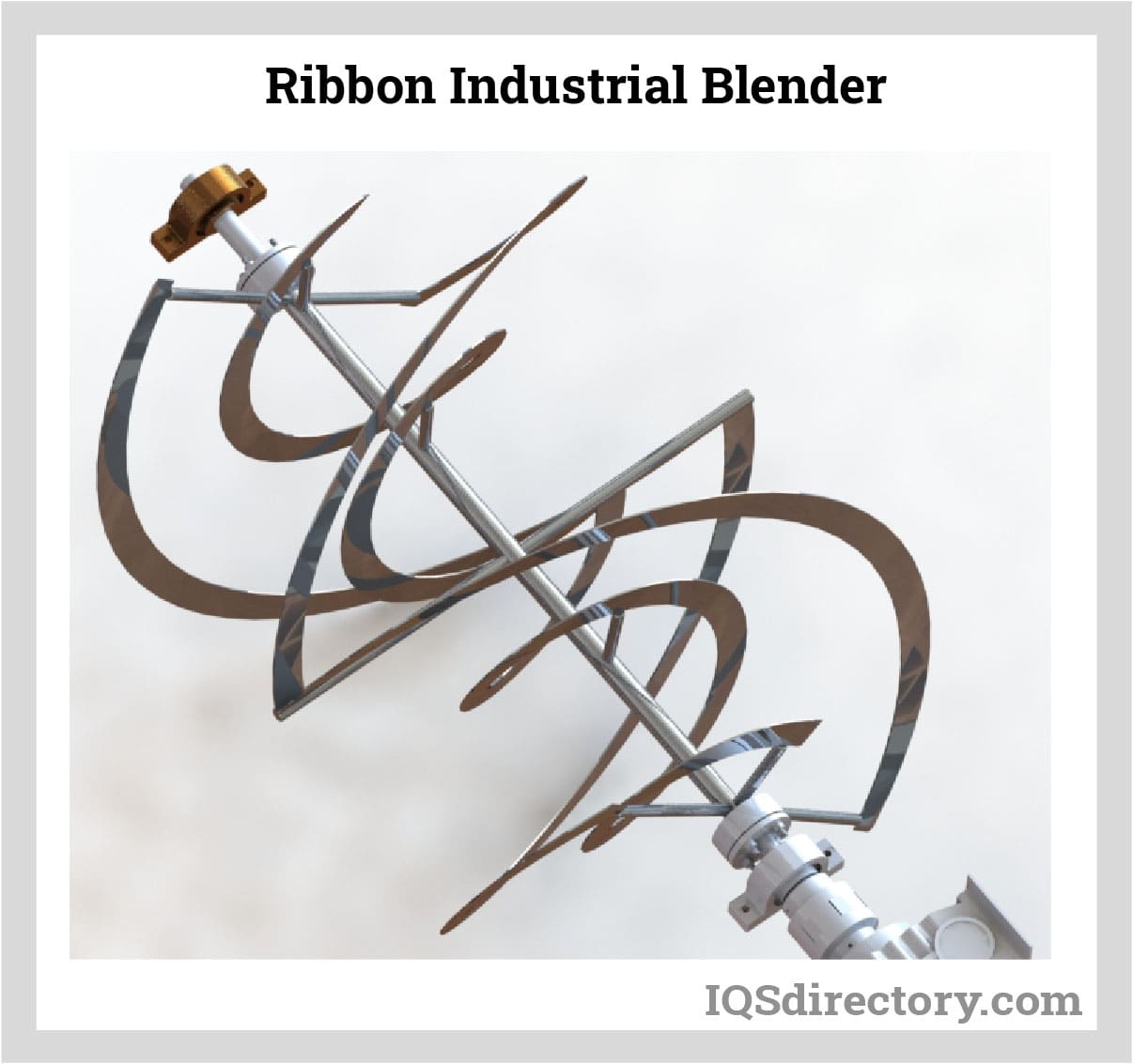
Rotary blenders, also known as rotary drum blenders, lack traditional blades or paddles inside. Instead, the interior of the rotating drum features welded baffles or lifting scoops, which eliminates the need for moving parts within the mixer. This design ensures a gentle mixing action that avoids shearing or damaging sensitive materials and is ideal for fragile products and bulk powders.
The mixing blades in a rotary blender create a fluidizing effect with each rotation, effectively blending bulk materials and keeping product degradation minimal. This unique motion allows for rapid and efficient mixing of a diverse range of bulk substances, such as seeds, grains, dietary supplements, minerals, and additives, making rotary blenders an excellent choice for industries that require homogeneous batch blending with minimal fines or heat generation.
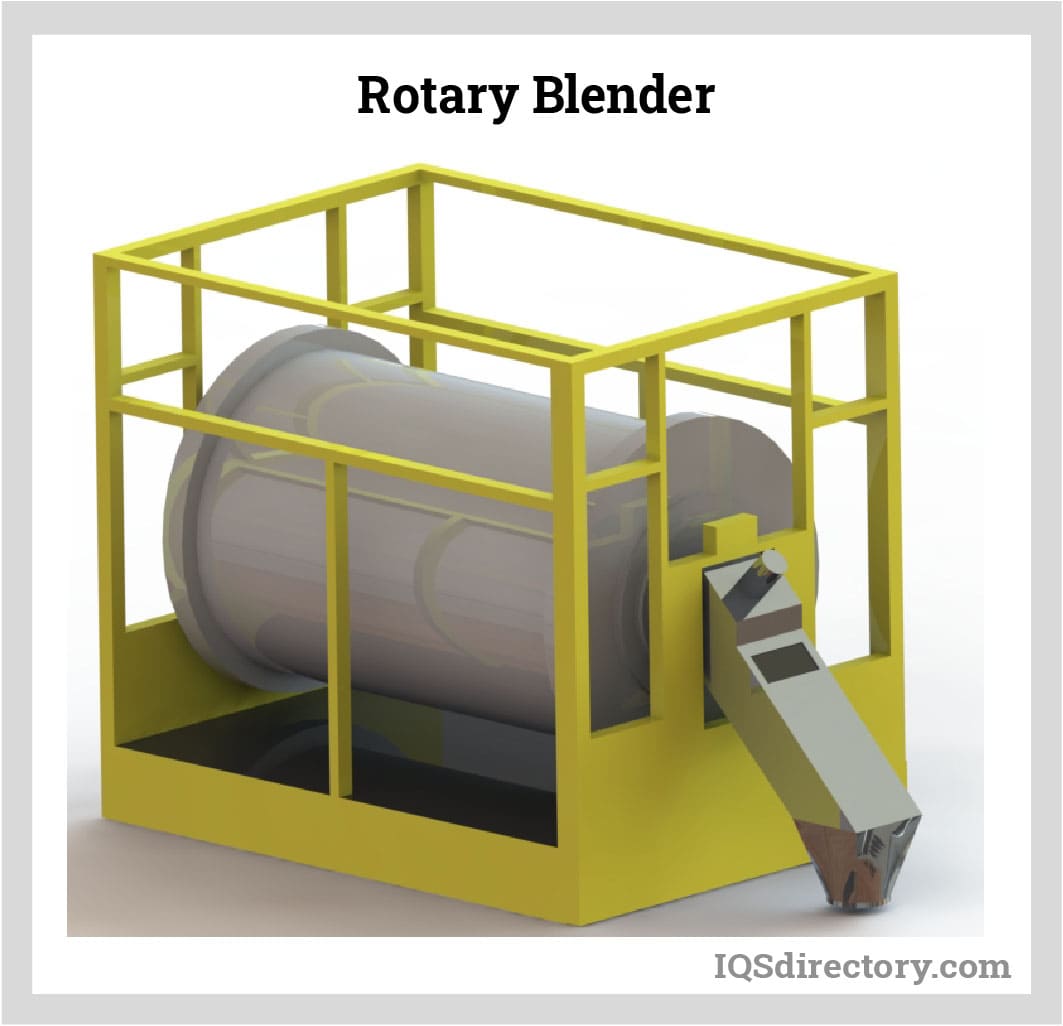
A double cone blender, also known as a tumble blender, rotates to mix materials and is designed with a compact footprint, requiring minimal installation space. As the cones rotate, the contents gradually move to the bottom of the vessel, facilitating uniform mixing through a rolling and cascading action. These blenders feature an access cover for easy cleaning and inspection, meeting stringent sanitary and validation standards in regulated industries. Utilizing the free flow method, double cone blenders provide gentle yet highly effective blending of granules and powders, with the capacity to mix up to five different ingredients simultaneously. This makes them ideal for pharmaceutical, food, and metal powder processing where cross-contamination and batch integrity are critical.
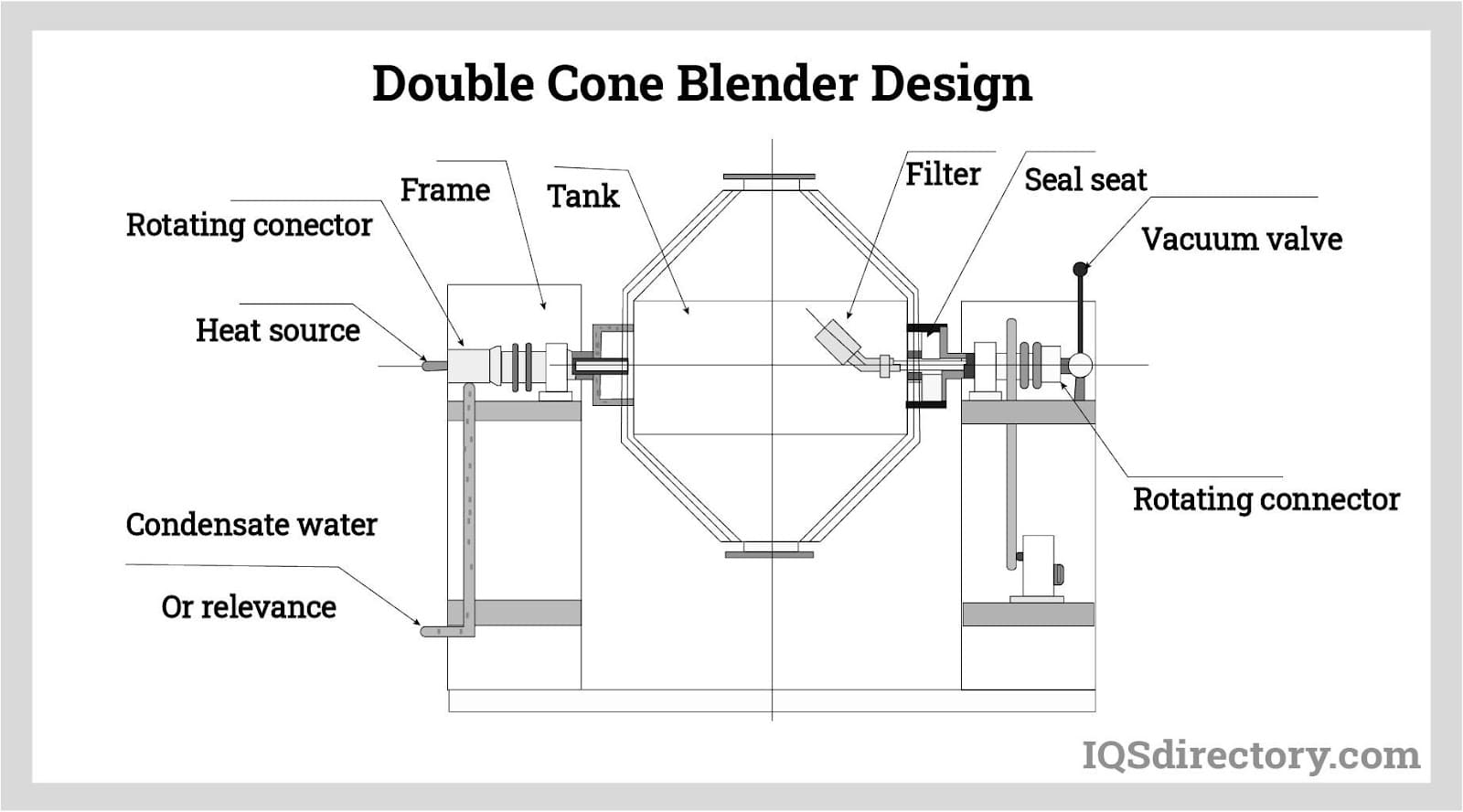
The V-shaped blender, also known as a twin shell blender or V-cone blender, uses rotation to tumble materials within its unique metal V structure. As the V rotates, materials are divided between its two wings and then blend back together. The wings are welded at angles of either 75° or 90°, optimizing the blend. This type of blender operates without internal moving parts and achieves efficient, reproducible blending with minimal rotations, making the process quicker compared to other industrial blenders.
Similar to double cone blenders, V-shaped blenders are well-suited for mixing free-flowing powders and bulk solid materials. The two openings are positioned at the top of each wing, facilitating easy discharge of blended materials and fast batch turnaround. V blenders are frequently used in the pharmaceutical, nutraceutical, chemical, and food industries for blending powdered ingredients, ensuring high-level mixing uniformity and containment.
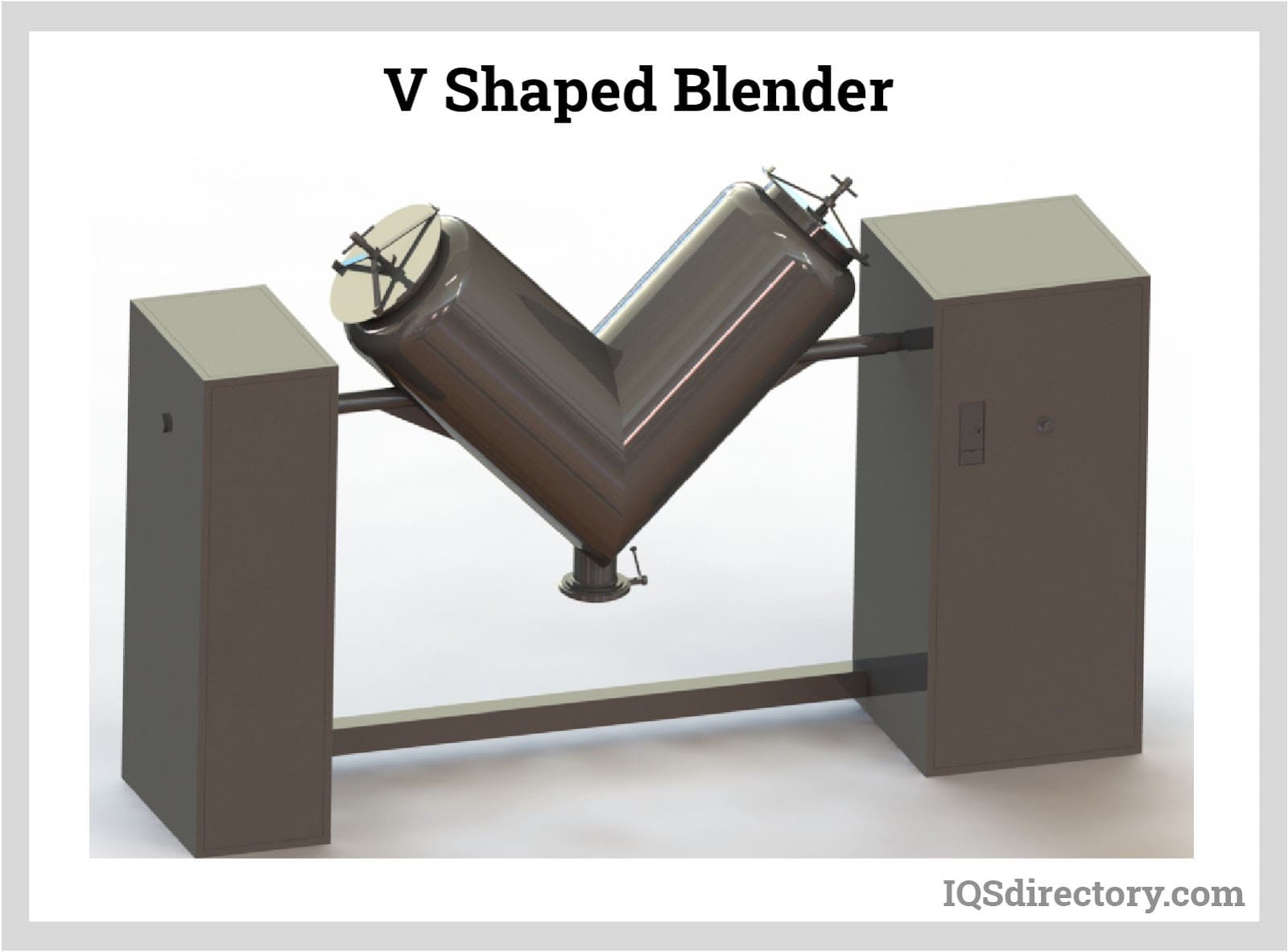
Vibrational blenders utilize ultrasonic sound waves to mix fine powders and achieve homogenization. This process is akin to that of an emulsifier, but instead of relying on pressure to blend and reduce liquids, vibrational blenders use ultrasonic waves to generate shearing forces at a microscopic level.
Ultrasonic waves passing through a liquid or slurry create vacuum bubbles or voids in a phenomenon known as ultrasonic cavitation. These bubbles expand under continuous wave exposure but eventually collapse when they can no longer absorb energy. This intense, localized energy release enables fine particle dispersion throughout the liquid medium.
Vibration blending offers precise process control over various aspects of the blending operation, including the amplitude, frequency, and duration of the ultrasonic waves. Industries such as pharmaceuticals, nanotechnology, electronics, and advanced materials use vibrational blenders for particle size reduction, emulsification, and even cell disruption.
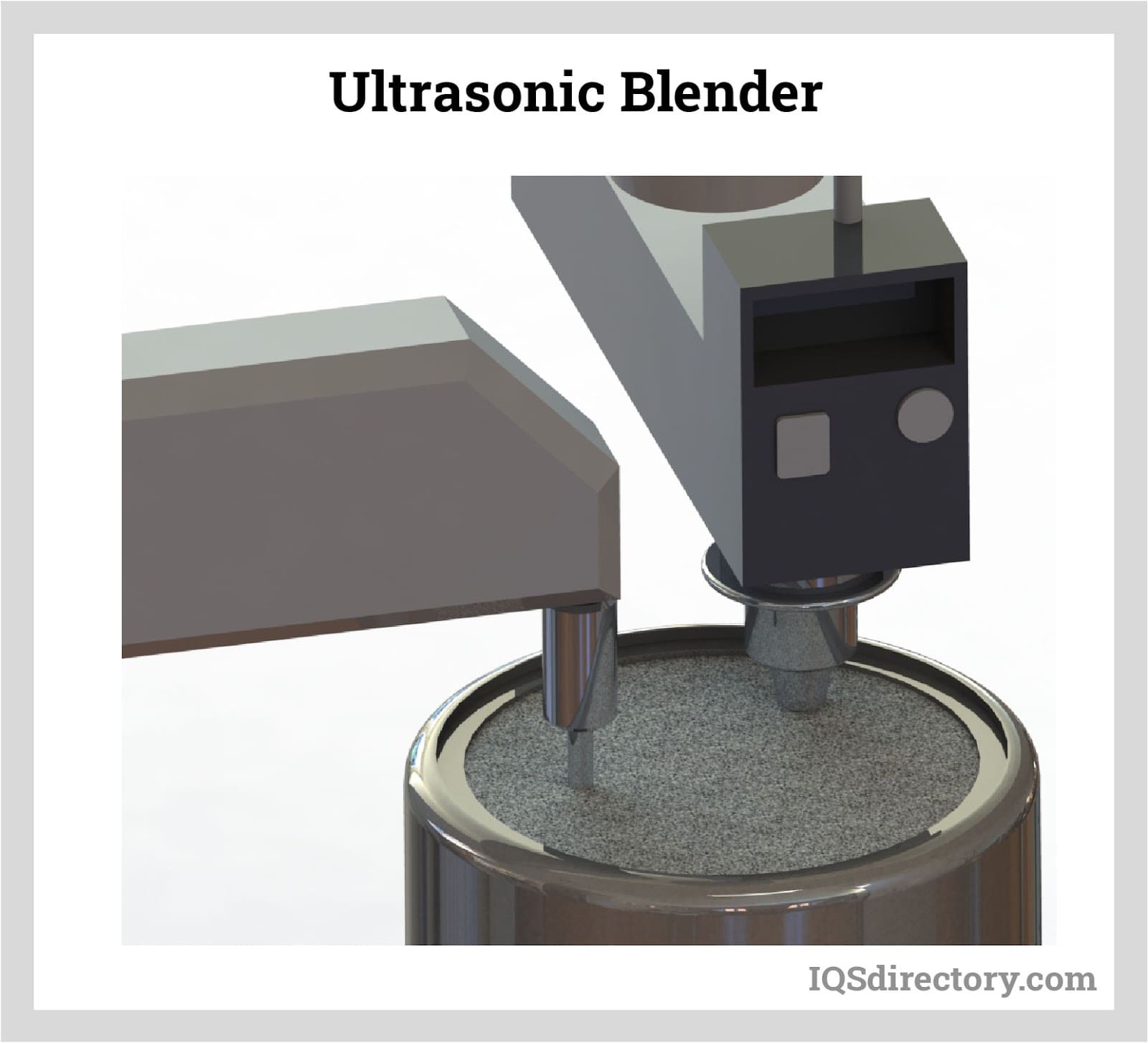
A homogenizer blender operates similarly to an emulsifier by breaking down unlike and unmixable substances, but with an emphasis on creating extremely fine particle size distribution. Homogenizer mixers use high shear force, pressure, and often ultrasonic or mechanical energy to reduce particle or droplet size, producing smooth, stable, and uniformly consistent compounds. This makes homogenizer blenders an excellent method for blending and processing products that require intensive mixing—such as dairy products, creams, beverages, pharmaceuticals, and cosmetics. Various methods are used by a homogenizer, including ultrasound, high-pressure processing, and rotor-stator blending technologies.
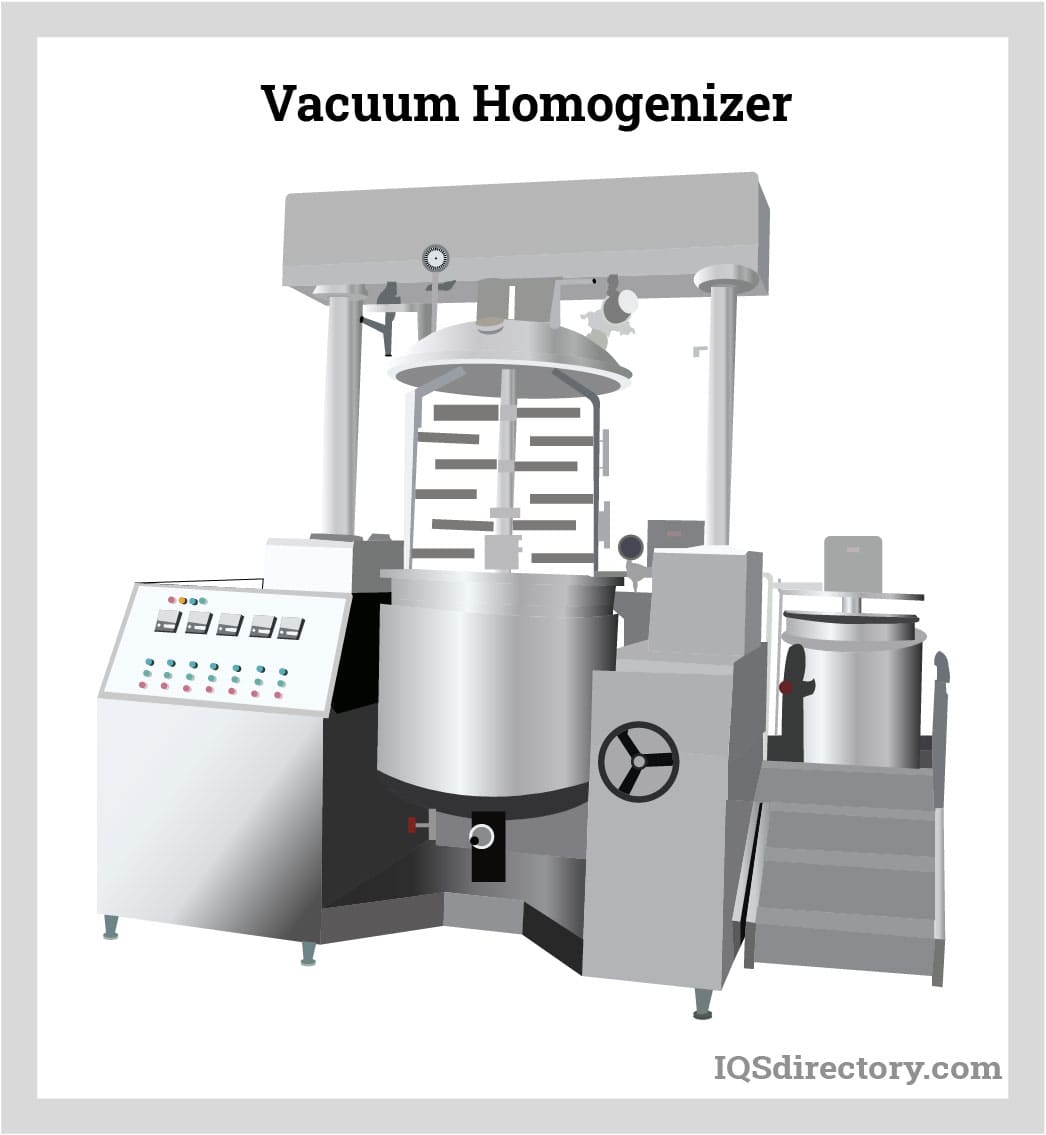
Vacuum blenders come in both horizontal and vertical configurations and are essential for sensitive or oxygen-reactive blending applications. They utilize a combination of heat and internal vacuum pressure to mix materials effectively while simultaneously removing air and minimizing oxidation or contamination. Additionally, vacuum blenders can also function as vacuum dryers during the blending process, making them valuable in industries such as pharmaceuticals, food processing, and specialty chemicals. The design of a vacuum blender mirrors that of a traditional mixer but incorporates a dedicated vacuum pump connected to an airtight blending chamber.
The vacuum pump removes air from the chamber, creating a low-oxygen, controlled environment in which blending can occur. This is especially beneficial for processes requiring the prevention of aeration, foaming, or microbial growth, and for those requiring residual moisture removal for downstream processing.
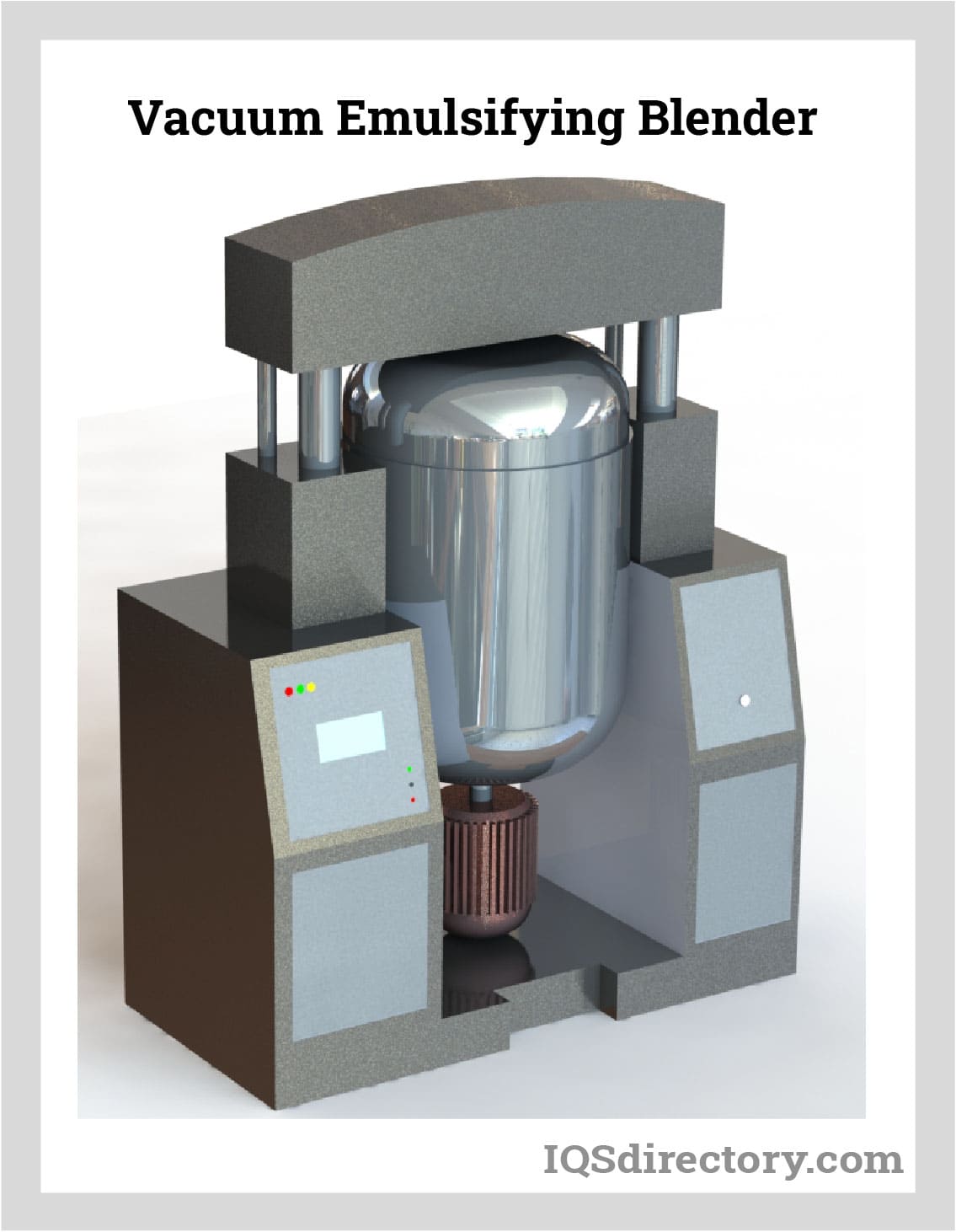
A mass blender features a cabin that rotates on a horizontal plane, similar in design to a rotary blender, with blades or lifting bars welded to the interior sides of the chamber. These blenders are ideal for handling lumpy and dry materials, as well as small granular substances or abrasive powders. Mass blenders are available in models with capacities ranging from 50kg to 150kg and are widely used in industries such as construction, ceramics, and powder metallurgy due to their efficient handling of dense, heavy duty materials.
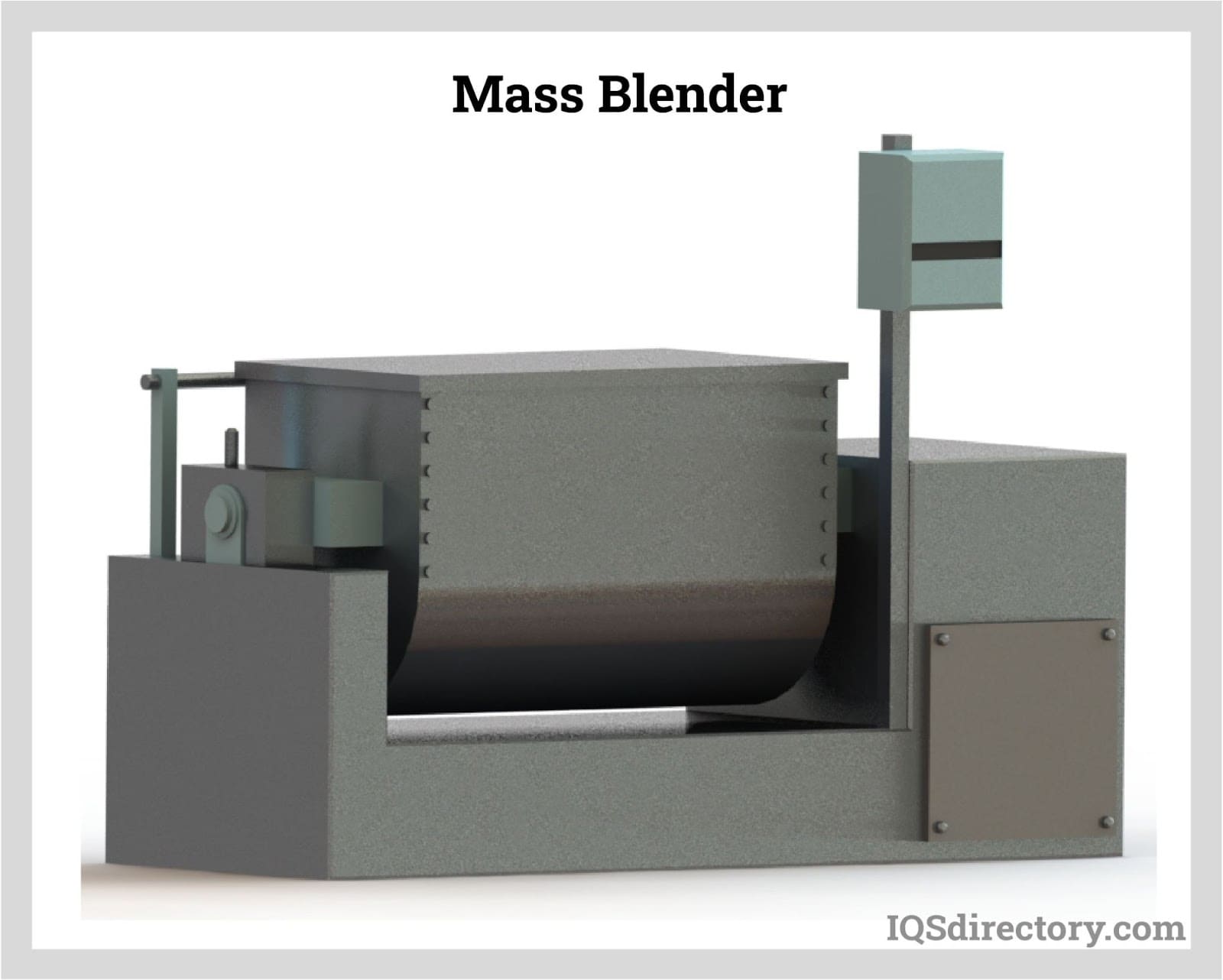
Featuring an octagonal design with polygonal top and bottom sections, an octagonal blender is equipped with internal baffles that facilitate efficient and effective mixing. It is particularly well-suited for gently blending powders and granular materials without generating excessive dust or heat. To achieve optimal performance and homogeneous blending results, the blender should be filled to approximately 70% of its total capacity. This prevents insufficient mixing or product layering.
The superior blending performance of an octagonal blender is attributed to both its slow rotational speed and its unique octagonal chamber shape. This design enables materials to converge from all sides, minimizing the need for high RPMs and preventing product damage. The gentle, continuous tumbling cycle ensures that materials remain in consistent motion, resulting in highly efficient batch blending processes for pharmaceutical, chemical, and nutraceutical industries where blending accuracy and contamination prevention are essential.
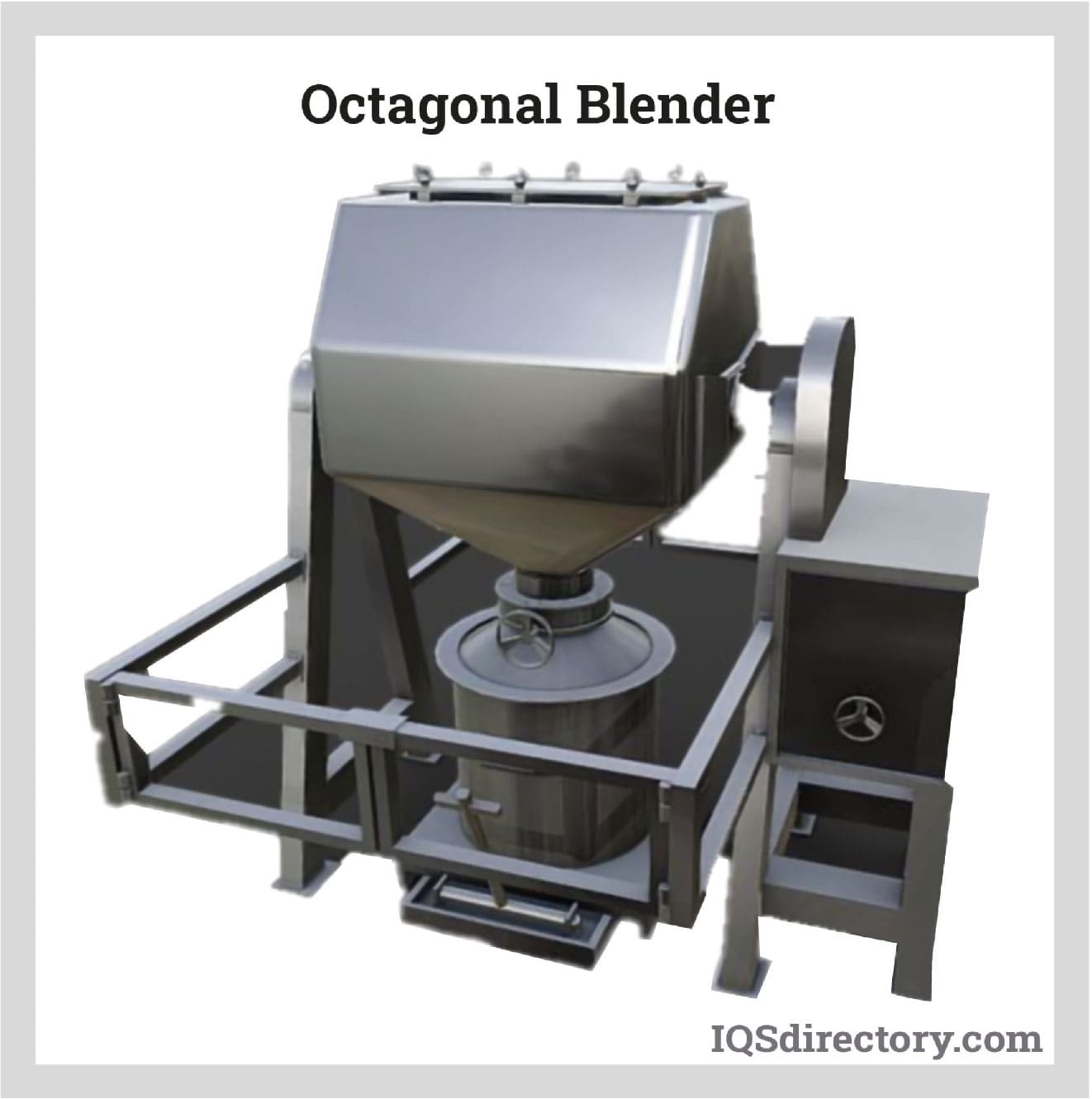
Twin screw low pressure extruders (TSE) are advanced mixers known for their intense, thorough mixing capabilities. Unlike standard extruders, TSEs feature two interlocking screws that enhance mixing efficiency at lower temperatures, which is valuable for shear-sensitive or heat-sensitive formulations. They are often employed in continuous processing lines, allowing for portioning, compounding, and intense premixing before materials are transferred to a high-pressure extruder for shaping or further processing.
Twin screw low pressure extruders (TSEs) provide a more intense and aggressive mixing process compared to standard blending techniques. They feature a high solids loading ratio, which denotes the proportion of solid material within the liquid mix, making them crucial for polymer compounding, plastics manufacturing, food extrusion, and chemical process industries where uniform dispersion of additives, fillers, or colorants is required.
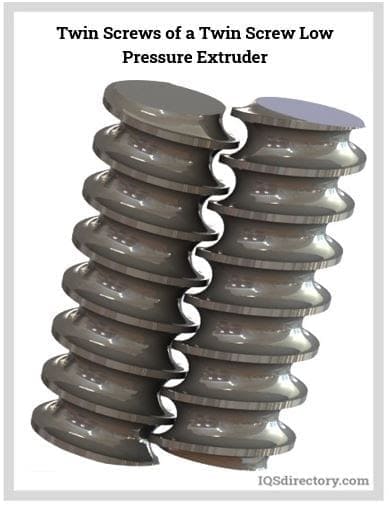
Static mixers are used to continuously blend fluids and materials in flow streams using stationary, rigid mixing elements placed in a pipeline with flanged connections at either end for secure installation. These passive mixing devices are constructed using baffles or structured elements, which are made of plastic or metal.
In static mixers, the flow stream itself drives the mixing process because there are no moving parts involved. The number of mixing elements can range from one to four, or more, based on the application's requirements and target mixing intensity. Additional elements can be incorporated as needed to enhance the mixing efficiency in challenging environments or for high-viscosity fluids.
Static mixers are commonly employed in shell and tube heat exchangers to improve heat transfer efficiency and in process pipelines for inline blending, dilution, and chemical dosing. They offer a cost-effective, maintenance-free solution for enhancing heat transfer, homogeneity, and product quality by affecting the film or wall coefficients, thereby optimizing thermal performance in industries such as water treatment, oil & gas, food and beverage, and chemical processing.
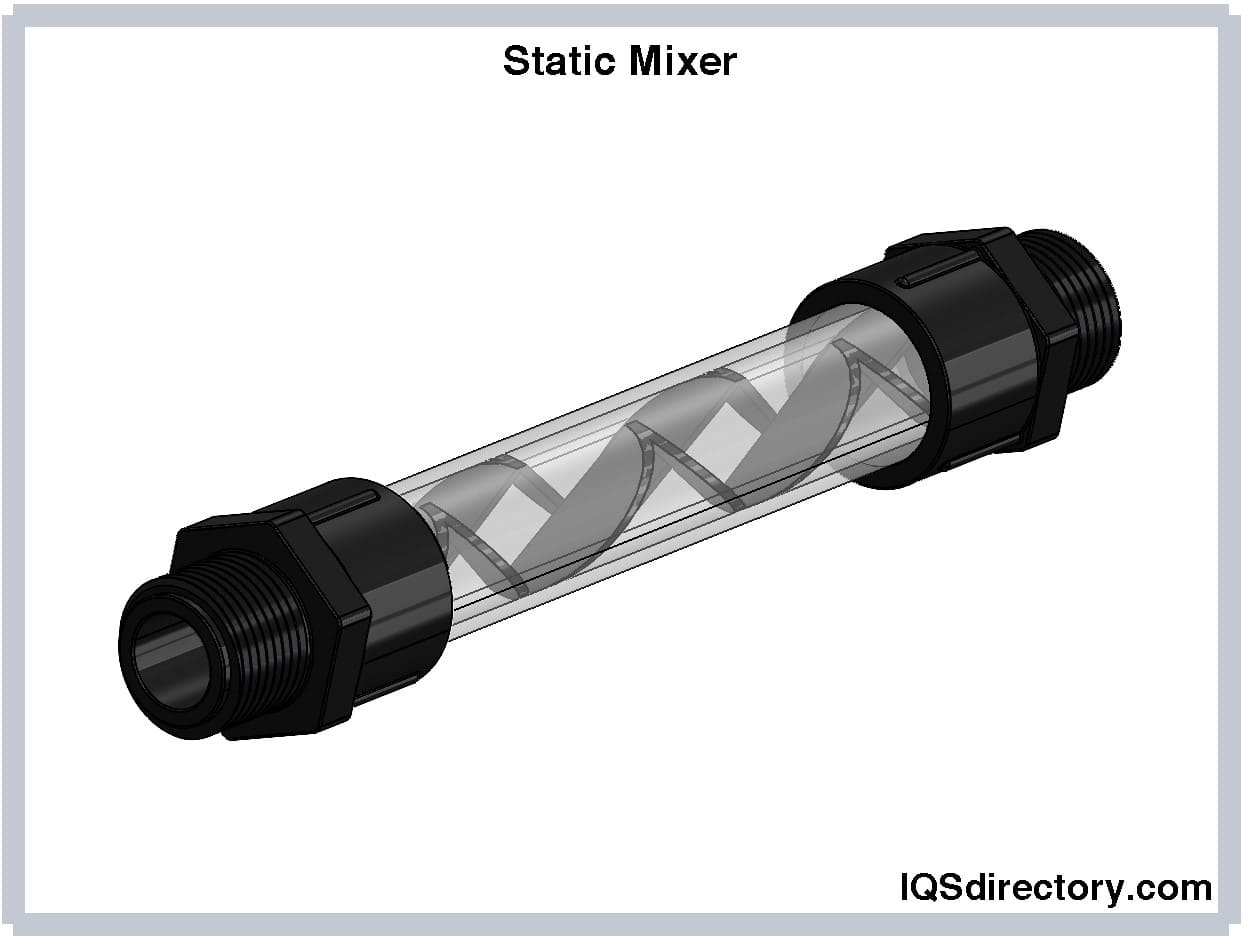
Vertical blenders are well-suited for shear-sensitive materials, fine powders, and situations where floor space is limited. They feature a slowly rotating blending screw or auger, which is gentler compared to horizontal blenders and ideal for delicate or friable products. The screw spirals through the conical chamber, gently lifting material upward. When the material reaches the top of the cone, it falls back through the center to the bottom, ensuring thorough, even blending and excellent mixing accuracy.
The screw in a vertical blender is a contra-rotating helical ribbon that generates four cross flows: three driven by forced movement and one by gravity. An upward flow pushes material along the chamber's periphery while gravity causes it to fall in the center. The slow rotation speed and enclosed design of vertical blenders make them suitable for use in hazardous environments, dust-sensitive applications, and product containment processing. Power for the screw is provided by a gearmotor with a right-angle axis, ensuring consistent blending and efficient output from the kinematic chain.
The innovative design and high efficiency of a vertical blender enables it to handle a variety of batch sizes, starting at just 10% of its total capacity. Once blending is complete, the materials can be easily discharged through a valve located at the bottom of the conical chamber. Vertical blenders are favored in the pharmaceutical, chemical, and food industries for precise batch processing, reduced cleaning time, and compact installation requirements.
Industrial blenders play a vital role in manufacturing processes across diverse industries. Each type of industrial mixer is crafted through a manufacturing process tailored to its specific shape, size, and the material blending requirements of the application, whether it be for dry powders, granules, viscous pastes, or liquid slurries. Commonly made from high-strength steel, stainless steel, aluminum, or cast iron, stainless steel is the most frequently used material—especially in food processing, pharmaceutical mixing, and chemical blending operations—due to its superior corrosion resistance and ease of sanitation. The construction of each blender is meticulously engineered to meet stringent industry standards for its intended use, ensuring robust mixing performance, product purity, and workplace safety.
Industrial blenders are extensively used in sectors such as pharmaceuticals, plastics, chemicals, cosmetics, nutraceuticals, and food production. A crucial feature of a quality industrial blender is its sealing system, which prevents material leakage, cross-contamination, and product waste. This necessitates precise engineering and design of all hatches, rotary valves, discharge doors, and other access points in the blender to ensure effective containment and hygiene, especially when processing sensitive or high-value bulk solids and ingredients.
Stainless steel is the industry standard material for manufacturing industrial blenders used in food and beverage processing, cosmetics production, and pharmaceutical applications due to its non-reactive surface and compliance with hygiene requirements like FDA and cGMP standards. In industrial settings where sanitation is less critical, blenders may be constructed from carbon steel, cast iron, or aluminum, balancing cost and durability. Specialty alloys may also be used for blending highly abrasive or corrosive materials found in chemical processing and industrial mixing operations.

After selecting the optimal metal based on application, the material is roll-formed using a twin roller press. The sheet metal is repeatedly passed through the precision rollers to shape it into the classic "U" configuration common in ribbon blenders and paddle mixers, which provides efficient tumbling and uniform blending of dry powders, granules, and bulk solids. The roll forming process ensures strength, material uniformity, and the geometric precision necessary for high-performance mixing vessels.
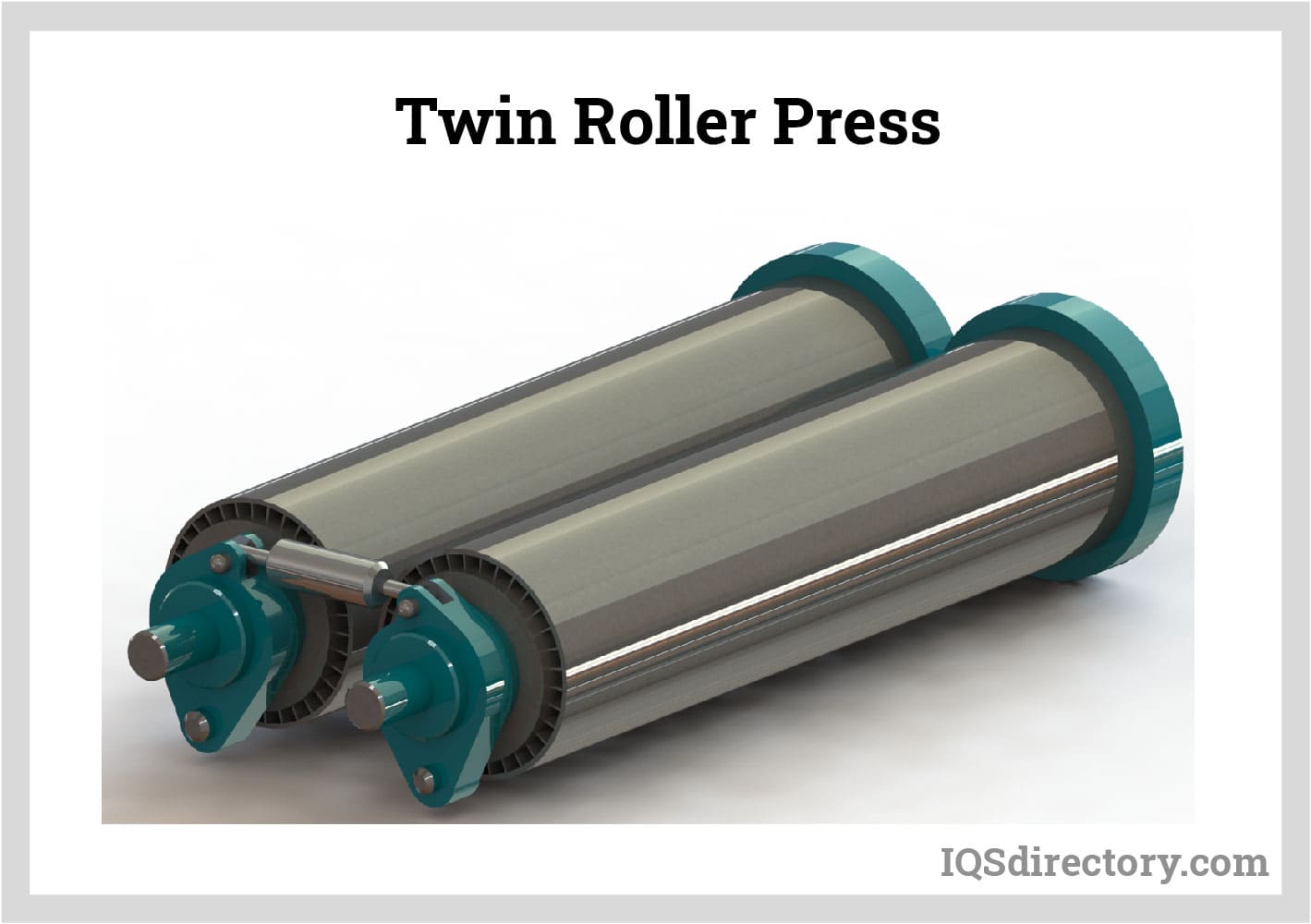
The roll-formed "U"-shaped metal piece is precisely welded to the blender's end plate to form a leak-proof vessel. Spot welding techniques are utilized to secure the shell to the end plate, applying the weld horizontally along the interface where the curved sheet meets the plate, ensuring structural integrity and a sanitary, easy-to-clean surface inside the industrial mixer.
The image below illustrates the orientation and execution of the perpendicular spot welds used for this critical stage of industrial blender manufacturing.
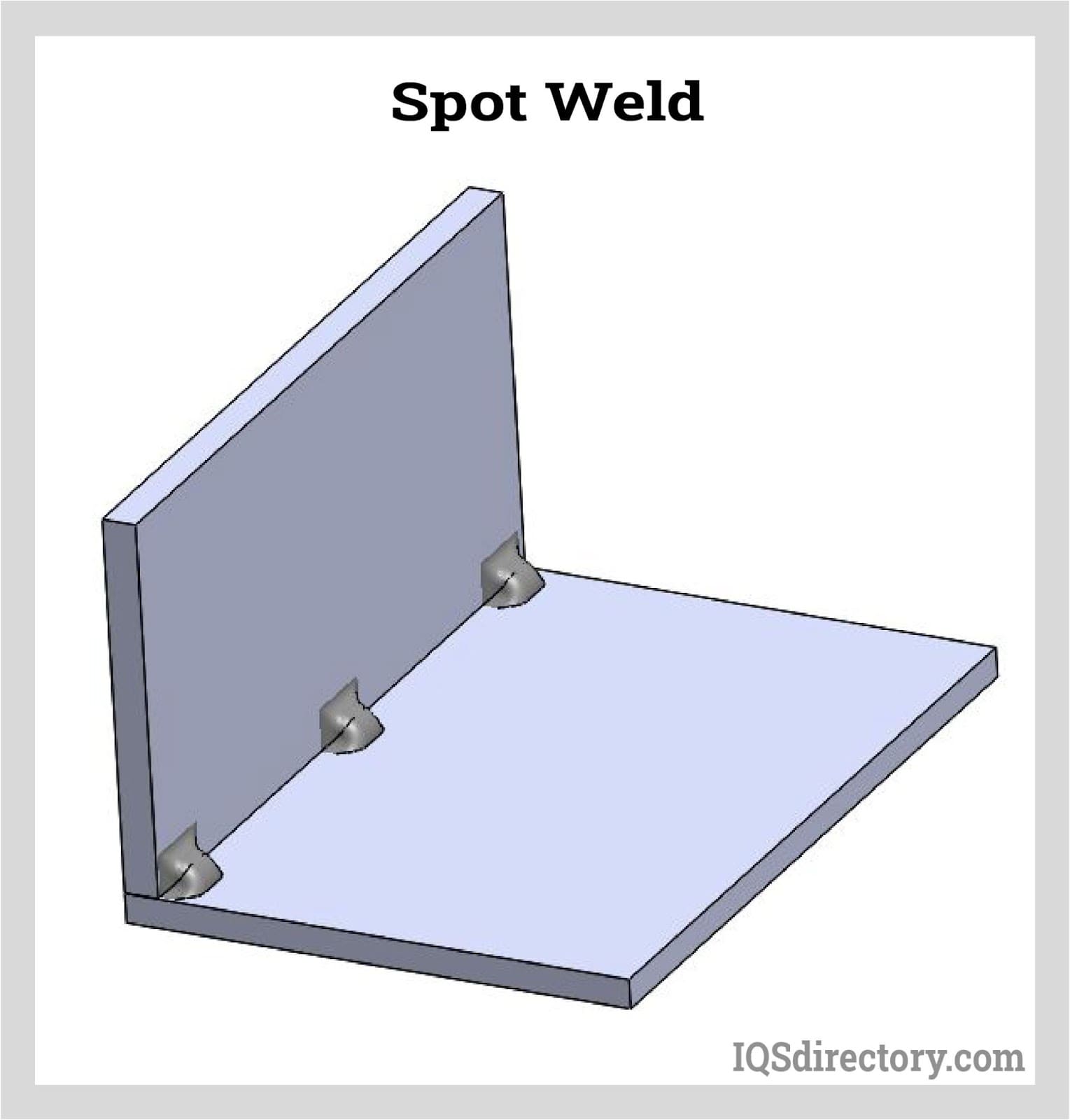
The paddles or agitators, which provide effective mixing and shearing action, are typically fabricated from stainless steel for durability and corrosion resistance. Advanced manufacturing methods are employed to cut paddle profiles from a plate of stainless steel, such as computer-controlled laser cutting, waterjet cutting, or plasma cutting, depending on the desired level of precision and production speed.
One widely used cutting technique involves using a plasma cutter. Plasma cutting offers clean, accurate lines and angles, which are critical for ensuring that each paddle fits perfectly into the assembly and performs optimal mixing. After cutting, the paddles are pressed or curved to refine their lifting, blending, or scooping abilities, ensuring efficient and consistent agitation of mixing materials such as powders, resins, and particulate blends.

The main shaft of the blender acts as the rotating axis and structural backbone of the entire mixing system. It provides the necessary rotational force to activate the agitator assembly—be it ribbon agitators, plow blades, or paddle arms. Because the shaft must withstand significant torque and elevated temperatures, its engineering and sizing are informed by mechanical stress analysis. Smaller diameter shafts experience higher bending and torsional stress, making large-diameter shafts preferable for high-capacity industrial mixing where durability and reliability are crucial.
A keyseat is machined into the end of the shaft to facilitate a secure connection to the blender's main drive gearbox and ensure smooth, uninterrupted blending cycles.
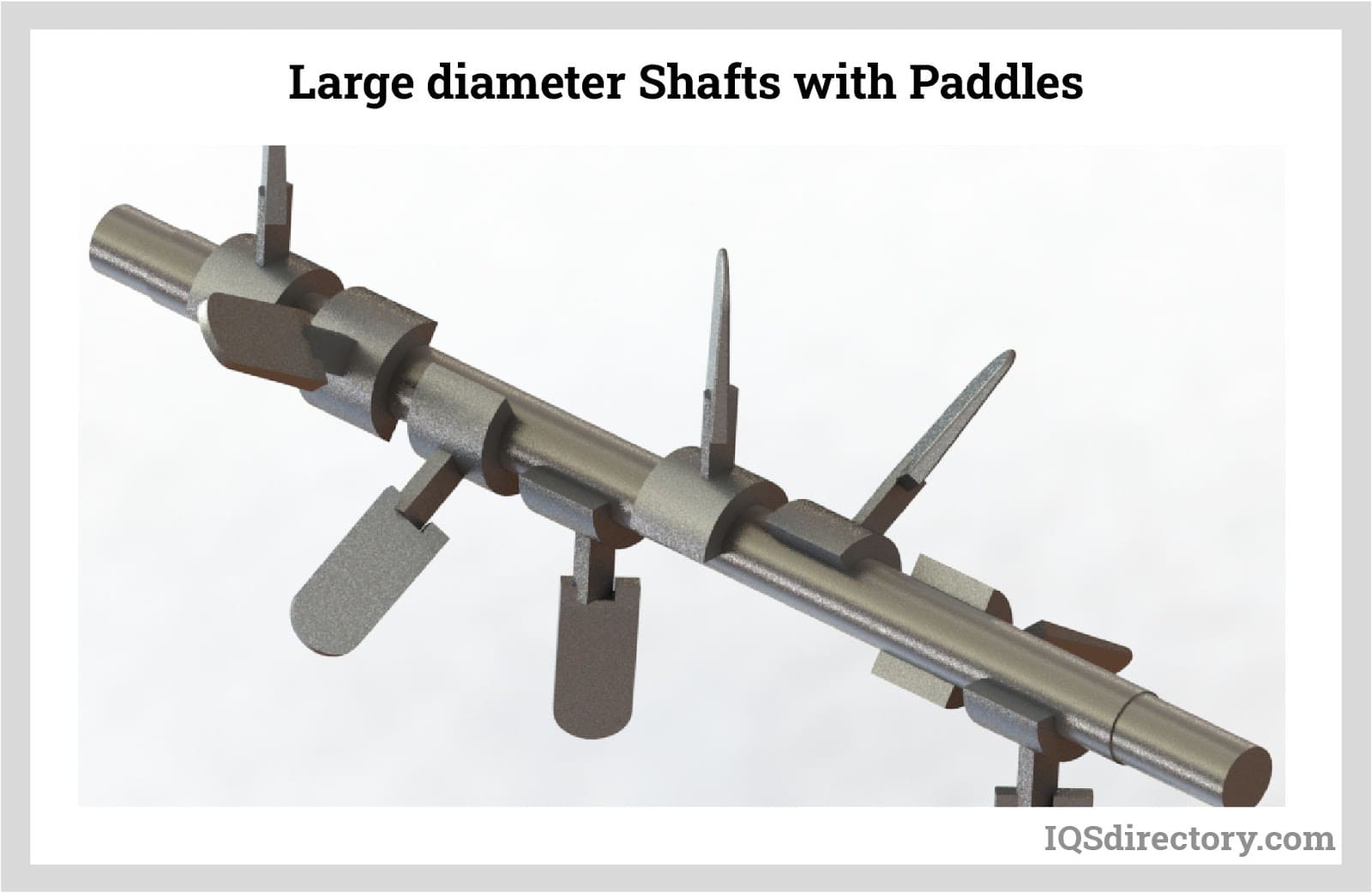
To firmly secure the paddles or mixing elements within the chamber, precision-engineered blender arms are bolted to the main shaft. These arms are designed with adjustable holes to facilitate customizable paddle spacing and clearance, optimizing mixing efficiency for different batch sizes, viscosities, and product densities. Both the paddle arms and agitator blades are installed at calculated angles and clearances, which are meticulously verified to prevent product buildup and ensure thorough, homogeneous mixing.
In certain industrial blenders—especially those used in sanitary applications such as food processing and pharmaceutical blending—the arms, paddles, and main shaft are all welded together, creating a seamless and rigid assembly. Welded connections are then ground smooth and polished, minimizing crevices and potential contamination points. This method provides maximum stability and greatly enhances cleanability and operator safety, which is especially valuable in reliable production environments.
Welded one-piece units are particularly favored in chemical, food, and pharmaceutical processing facilities due to easier maintenance and adherence to strict hygiene regulations.

The industrial blender motor, specified for torque, horsepower, and duty cycle, is mounted to the frame, with the drive assembly directly coupled to the agitator shaft. A high-quality taper bushing guarantees that the gearbox is accurately centered on the shaft, ensuring smooth transfer of mechanical power. Variable frequency drives (VFDs) may be integrated to offer speed and torque control during the blending process—critical for delicate mixing applications or where precise batch uniformity is needed.
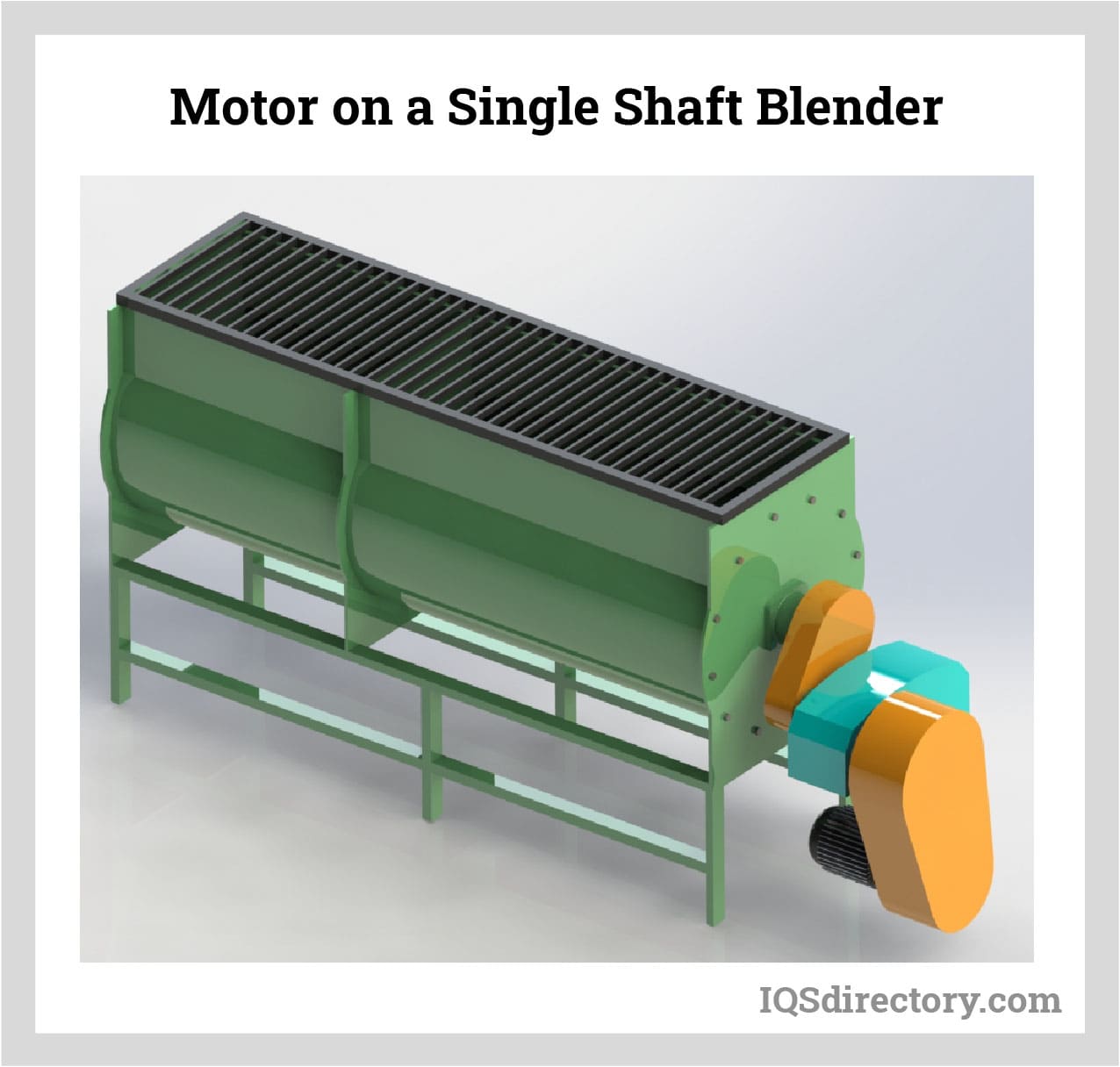
The majority of horizontal industrial blenders feature robust covers on the top of the mixing chamber for safe, easy access. These covers are fitted with safety grids or guards to protect operators from moving internal components and prevent foreign material contamination during operation. The covers allow for rapid loading and discharge of materials, as well as inspection and maintenance of the agitator shaft and paddles without compromising operator safety or batch integrity.
Upon installation of the covers and safety features, specialized monitoring devices—such as air pressure valves and safety limit switches—are incorporated to regulate internal pressure along the shaft and ensure safe, compliant operation in accordance with OSHA and industry safety regulations. Modern covers may also include access ports for sampling and cleaning to further enhance process control.
Control panels are an integral part of modern industrial blender functionality, providing comprehensive automation, process monitoring, and safety control. The control panel design and level of automation vary depending on the material characteristics, capacity, and level of process integration required. Leading manufacturers use Programmable Logic Controllers (PLCs) within the blender controls, which enable operators to fine-tune parameters such as mixing time, agitator speed, load weight, process temperature, and batch tracking with ease. PLCs improve efficiency by offering touchscreen interfaces, recipe management, automated alarms, data logging, and remote diagnostics.
Typically, custom-built PLC systems are developed from the ground up to match the specific requirements of each application. This ensures compliance with industry standards (such as food safety, pharmaceutical validation, or chemical regulatory requirements) and the flexibility to adapt to new formulations or production goals.
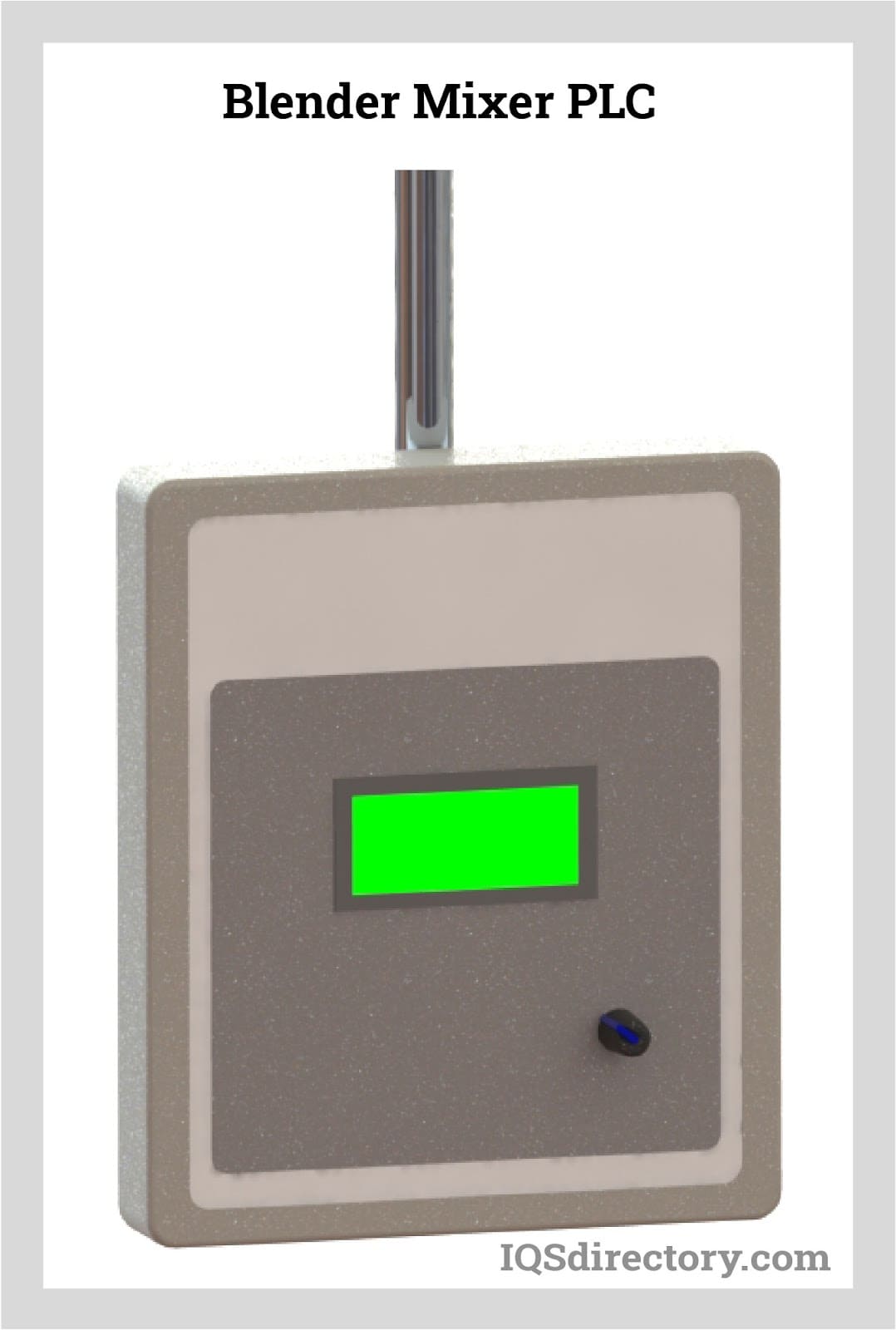
Leading industrial blender manufacturers offer significant customization options to meet unique process requirements—ranging from specialized agitator designs (like ribbon, paddle, or plow mixers) to sanitary finishes and integrated sensors for monitoring temperature, humidity, and mixer load. Factory acceptance testing (FAT), material trial runs, and third-party validation are frequently conducted prior to delivery to verify that the industrial mixing equipment meets all user specifications and industry certification requirements.
When evaluating industrial blenders for purchase, end users should consider a range of factors, including vessel size, batch capacity, material compatibility, ease of cleaning, required safety certifications, and total cost of ownership. Comparing features such as discharge valve design, cleaning systems (CIP/SIP), installation requirements, and after-sales technical support can ensure optimal process performance and investment returns.
For applications involving food ingredients, pharmaceuticals, or hazardous chemicals, manufacturers often provide documentation and validation support—including 3A, FDA, and ATEX certifications—for regulatory compliance and operational safety. By thoroughly assessing industrial blender features and manufacturing quality, buyers can confidently select a blender that optimizes mixing efficiency, product consistency, and plant productivity.
An industrial blender is designed for large-scale mixing of materials, enabling efficient blending and reaction processes in industries such as food, pharmaceuticals, chemicals, plastics, and construction.
Industries such as pharmaceuticals, food processing, chemicals, plastics, cosmetics, nutraceuticals, and powder metallurgy benefit from custom industrial blenders tailored to their specific mixing needs.
Sanitary industrial blenders are typically made from stainless steel and feature seamless welds, polished surfaces, smooth joins, and sealed assemblies to comply with hygiene standards and prevent contamination.
Key considerations include vessel size, batch capacity, material compatibility, ease of cleaning, required certifications, discharge valve design, available cleaning systems, safety features, and after-sales support.
Mixing actions include agitation, tumbling, shearing, emulsifying, homogenizing, ultrasonic vibration, rotary, ribbon, paddle, and static mixing—each suited to particular materials and process objectives.
Yes, stainless steel blenders are widely used in food and pharmaceutical manufacturing due to their corrosion resistance, easy cleaning, and compliance with FDA and cGMP standards.
Industrial blenders are crucial in manufacturing due to their large capacity, allowing for the formulation of products in substantial quantities. They enable the production of final mixtures in bulk, ensuring an efficient and seamless blending process that supports smooth and worry-free production.
Blenders are used globally across various industries to combine components and create products. Whether it's mixing ingredients for bread or blending polymers for plastic goods, blenders play a crucial role in completing the production process.
Pharmaceutical manufacturing demands equipment that ensures exceptional accuracy, consistency, cleanliness, and efficiency. Regulatory standards are in place to guarantee the safety and purity of medications for public use. Consequently, blenders used in the pharmaceutical industry are highly specialized and intricate to meet these stringent requirements.
Blenders in the pharmaceutical industry are used for preparing emulsions, reducing particle size, facilitating chemical reactions, altering material flow, and dissolving components. Due to the complex requirements of this industry, a variety of blending devices are employed to meet diverse needs.
The effectiveness of adhesive production hinges significantly on the blending process. Whether it’s homogenizing or dissolving, the type, size, and blending method play crucial roles in determining the efficiency and quality of the adhesive. Advances in blender technology have greatly enhanced the blending of adhesive materials, leading to improved product performance and application.
Adhesives that are produced using an industrial blender include epoxies, latex sealants, joint compounds, polybutene emulsions, polyurethane, and rubber cement, to name a few.
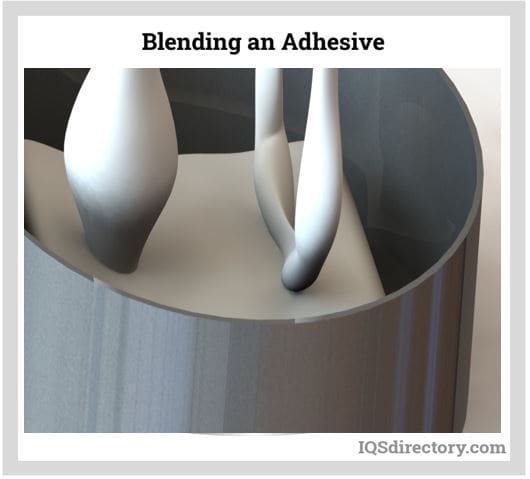
When people hear the term "blender," they often think of the countertop appliance used for making food at home. However, in the food industry, blenders are employed on a much larger scale. They are utilized for a variety of processes, including dry blending, emulsification, dissolution, dispersion, and the blending of highly viscous ingredients.
Blending plays a crucial role in converting raw ingredients into delicious and ready-to-eat food products. An industrial blender’s precision ensures the ideal texture and appearance for each product. With a range of available blenders, processors can choose smaller units for small-scale operations or larger, more durable machines for extended production runs.
In the plastics industry, blenders are essential for determining the type, strength, and molecular structure of plastics. The initial step in plastic production involves blending various polymers and chemical additives into a solid mixture. This critical process directly impacts the quality, design, and functionality of the final plastic material.

In the cosmetics industry, a significant challenge is blending materials that are not naturally compatible, which often involves emulsifying them to break down their molecular structures. Industrial blenders provide superior control and accuracy, allowing producers to blend these materials effectively without compromising their essential qualities.
The cosmetic industry demands blenders that can adapt to various consistencies, viscosities, and shearing requirements of different cosmetic materials. Industrial blenders are well-suited to meet these challenges effectively.
The industries described above represent just a few of the many that depend on industrial blenders for their processes. Any production process that involves the blending and mixing of various materials relies on industrial blenders to emulsify, blend, mix, and pulverize raw materials effectively.
| Industries and Their Blenders | |
|---|---|
| Aerospace | Candle Waxes |
| Aviation | Synthetic Leather |
| Batteries | Tobacco Products |
| Electronics | Cements |
| Cannabis | Ceramic |
| CBD Manufacturing | Metals |
| Chemicals | Inks |
| Glass | Paints |
| Pet Health Applications | Coatings |
Industrial blenders are versatile and can handle a diverse array of substances, including pellets, rocks, viscous fluids, and powders. Their robust construction, long-lasting performance, and dependable quality ensure they can effectively process any material with resilience and durability.
Industrial blenders boast a high tensile strength steel construction, which allows them to handle a wide variety of materials with minimal restrictions. This durability makes them essential tools in material processing and production.
When mixing dry powders, no liquids or water are added to ease the material for the blender. In the food sector, dry powders include coffee grounds, baking mixes, flavorings, spices, flour, tea leaves, and frozen goods. In the chemical sector, dry powders encompass powdered soaps, custom chemicals, ceramics, and plant nutrients.
Blending dressings and spreads with precision demands careful attention and thorough planning, as improper mixing can compromise the flavor and quality of the end product. The challenge is heightened by using oil as the primary ingredient. This process is time-consuming and typically does not involve the use of blades or mixers.
Dry pet food undergoes a blending procedure designed to create a solid texture that fractures and crumbles when chewed. An industrial blender refines and optimizes the texture, shape, and composition of the dry pet food.
Among all food products, sauces present the greatest challenge to prepare due to the need for exact blending of precisely measured ingredients. Blending too rapidly can lead to a sour taste, while blending too slowly may result in an incorrect consistency. Advanced PLC control in industrial blenders helps achieve the perfect sauce by managing the blending process effectively.
Creating confections involves a blending process similar to that of sauces, demanding the same level of precision. Traditionally, candies and sweets were crafted by hand on large heated surfaces, requiring extensive time for forming, churning, and shaping to achieve the right consistency. Today, industrial blenders have significantly reduced this time, allowing for the efficient preparation of large batches with the desired consistency in much less time.
Preparing bases requires meticulous attention and considerable patience. Sometimes, chefs keep the ingredients and their proportions secret. Industrial blenders are perfect for creating these confidential bases, as they ensure precise ingredient ratios and allow for optimal blending speed and duration.
Syrups are created by mixing preservatives with raw sweeteners in water. This process often involves vigorous blending using fast-moving paddles and agitators. A key aspect of this blending is the shearing of the ingredients to ensure thorough dissolution.
Polymer blending involves combining different polymers without the need for bonding agents. This method aims to quickly and cost-effectively produce materials with unique and complex properties. The resulting blended polymers often exhibit enhanced characteristics compared to the individual polymers, leveraging the strengths of both to create superior materials.
In industrial polymer blending, a significant challenge is ensuring the miscibility of the polymers. The process often necessitates intense pulverization to break down the molecular structures of the materials, facilitating their effective blending.
Metal blending occurs when metals are reduced to a powder form. The particle size and shape influence the blending method chosen for their combination. This process results in a material that harnesses the properties and benefits of each metal. By breaking down the metals' molecular structures, the blending creates a unified substance with enhanced characteristics.
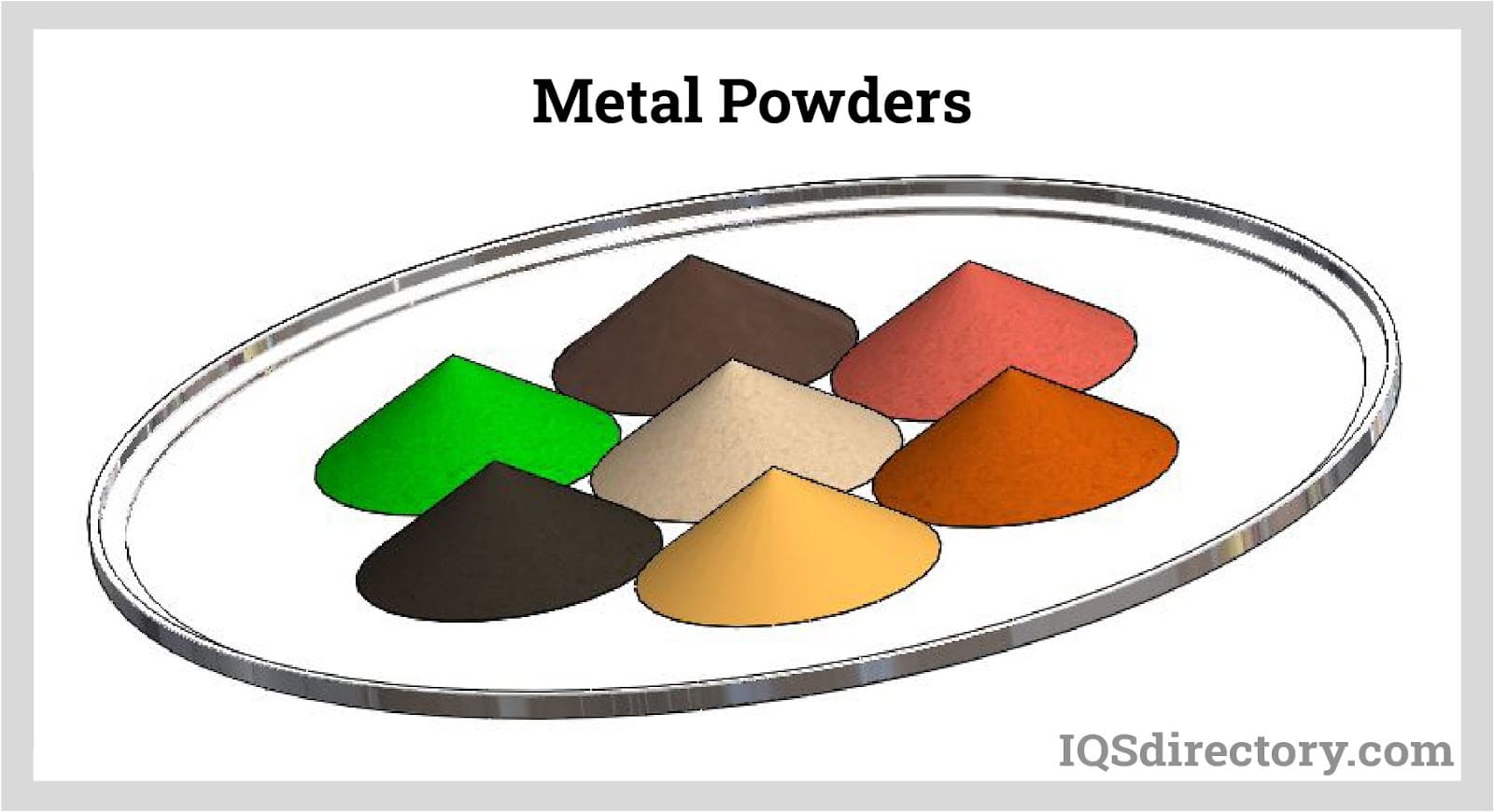

Agitators are equipment used in homogenizing media inside a tank. It works by rotating the impeller at its immersed end at a controlled speed or revolutions per minute (rpm). The work exerted by...
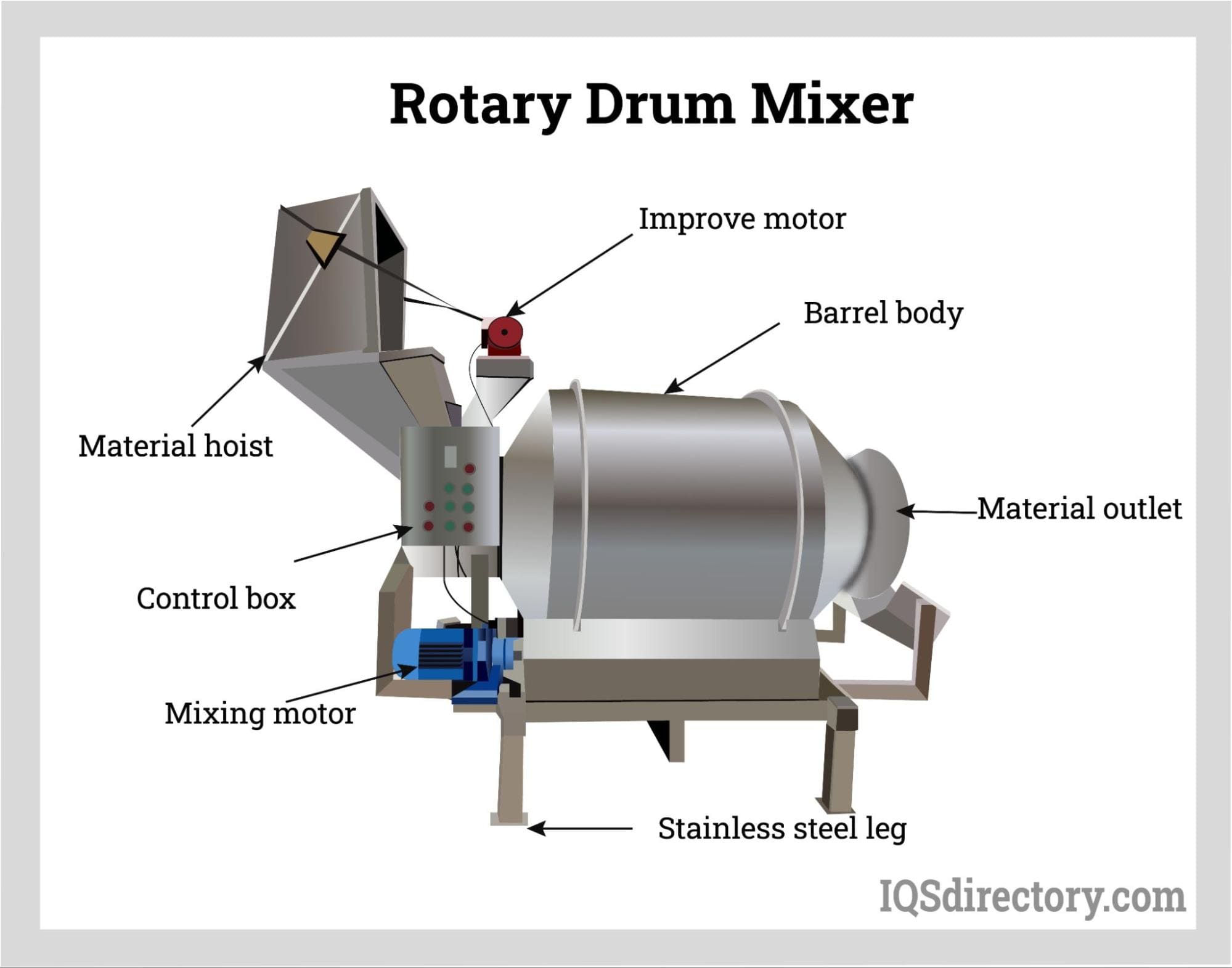
Drum mixers are mixers that are used for mixing free flowing materials by rotating them forward and reverse with welded chutes or flights that fluidize the mixture. The design of drum mixers gives them...
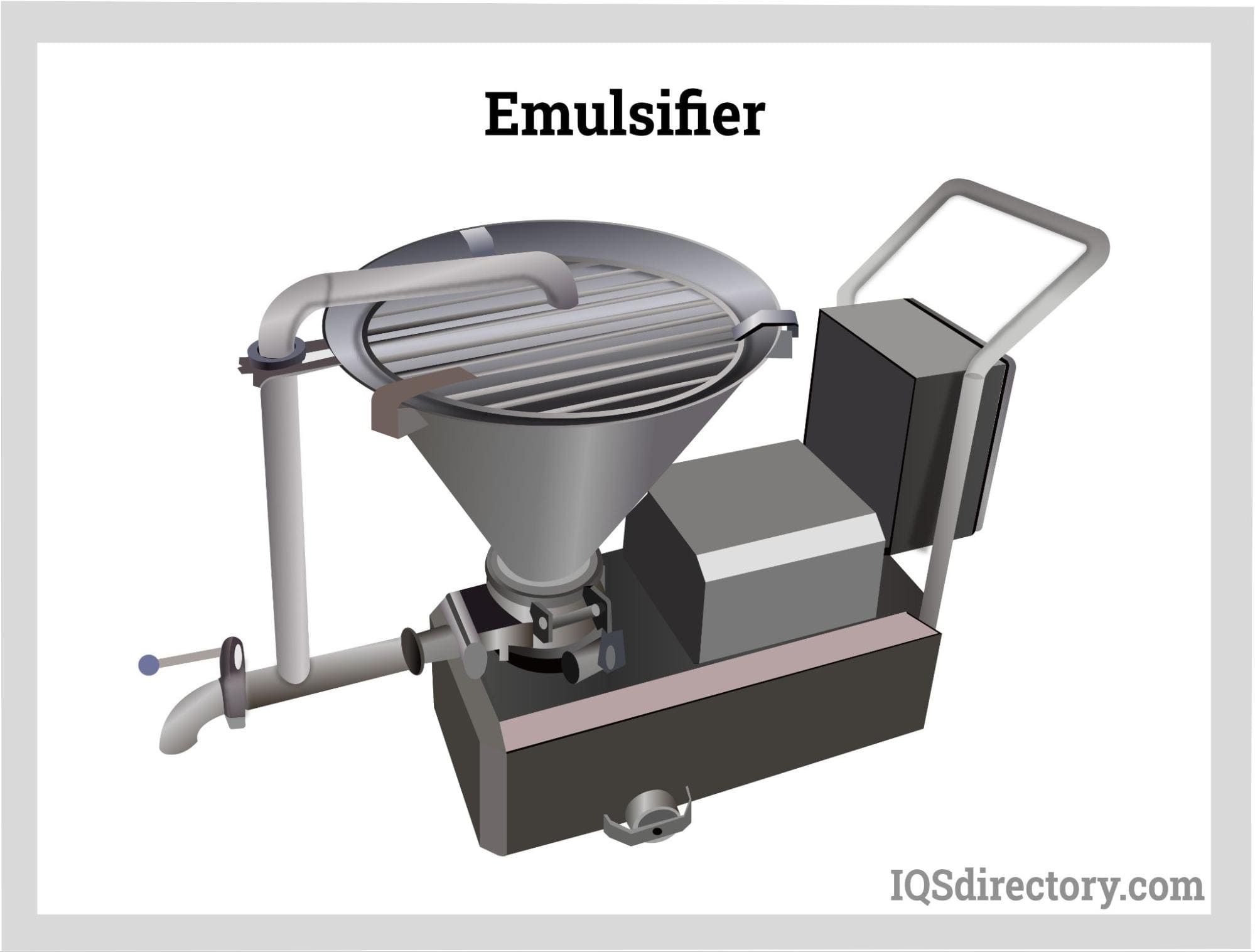
An emulsifier is an emulsion device used for colloidal dispersion of liquid droplets of immiscible liquids in the presence of an emulsifying agent. It enables the combining of non-soluble solutions or liquids...
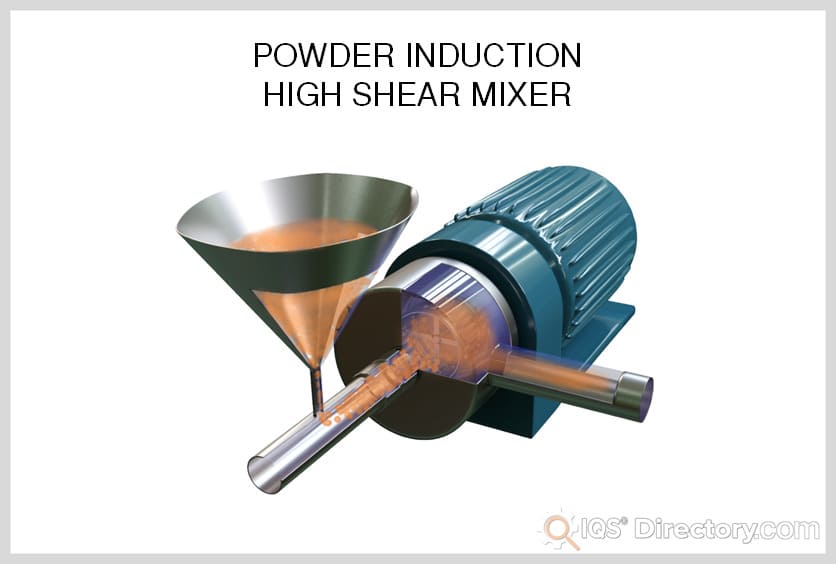
High shear mixers, also known as high shear reactors (HSRs), rotor-stator mixers, and high shear homogenizers, are used to emulsify, homogenize, disperse, grind and/or dissolve immiscible mixtures with components of the same or different phases...
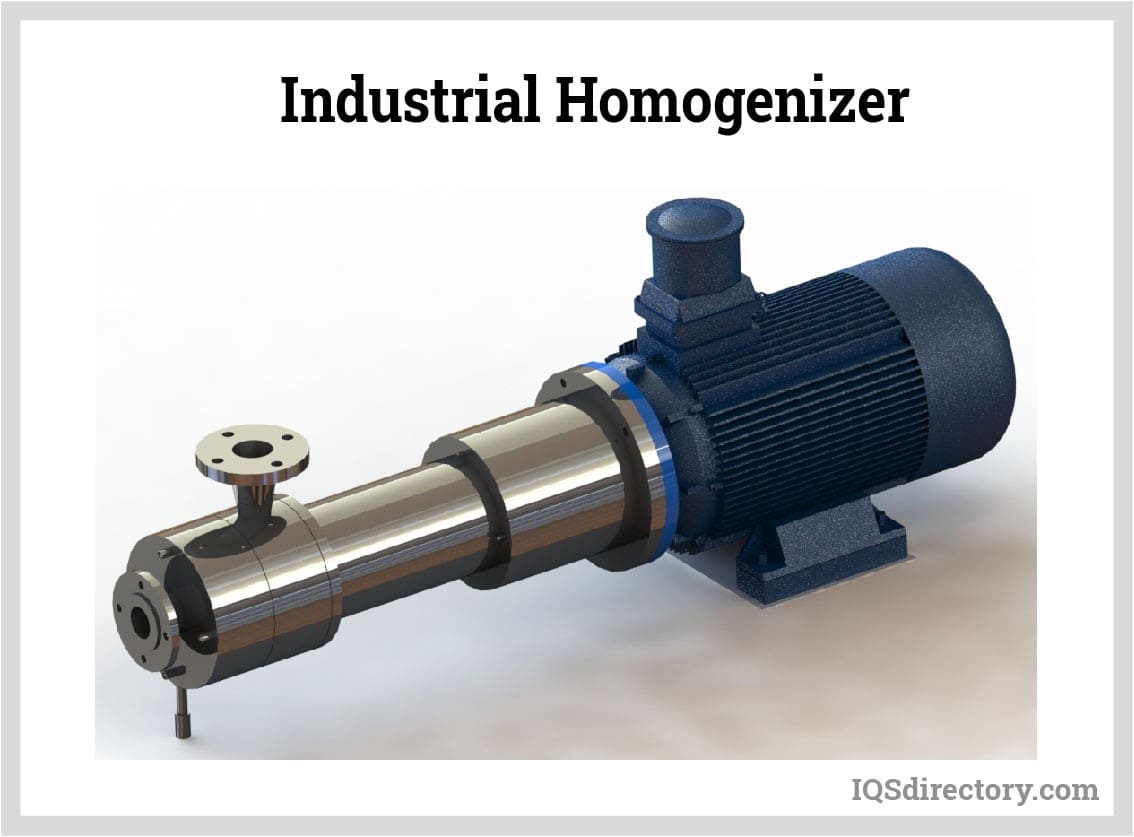
A homogenizer is a type of mixing equipment used to create a uniform and consistent mixture. It works by breaking the components and evenly distributing them throughout the solution. The components are either immiscible, have varying sizes, or are in different phases from each other...
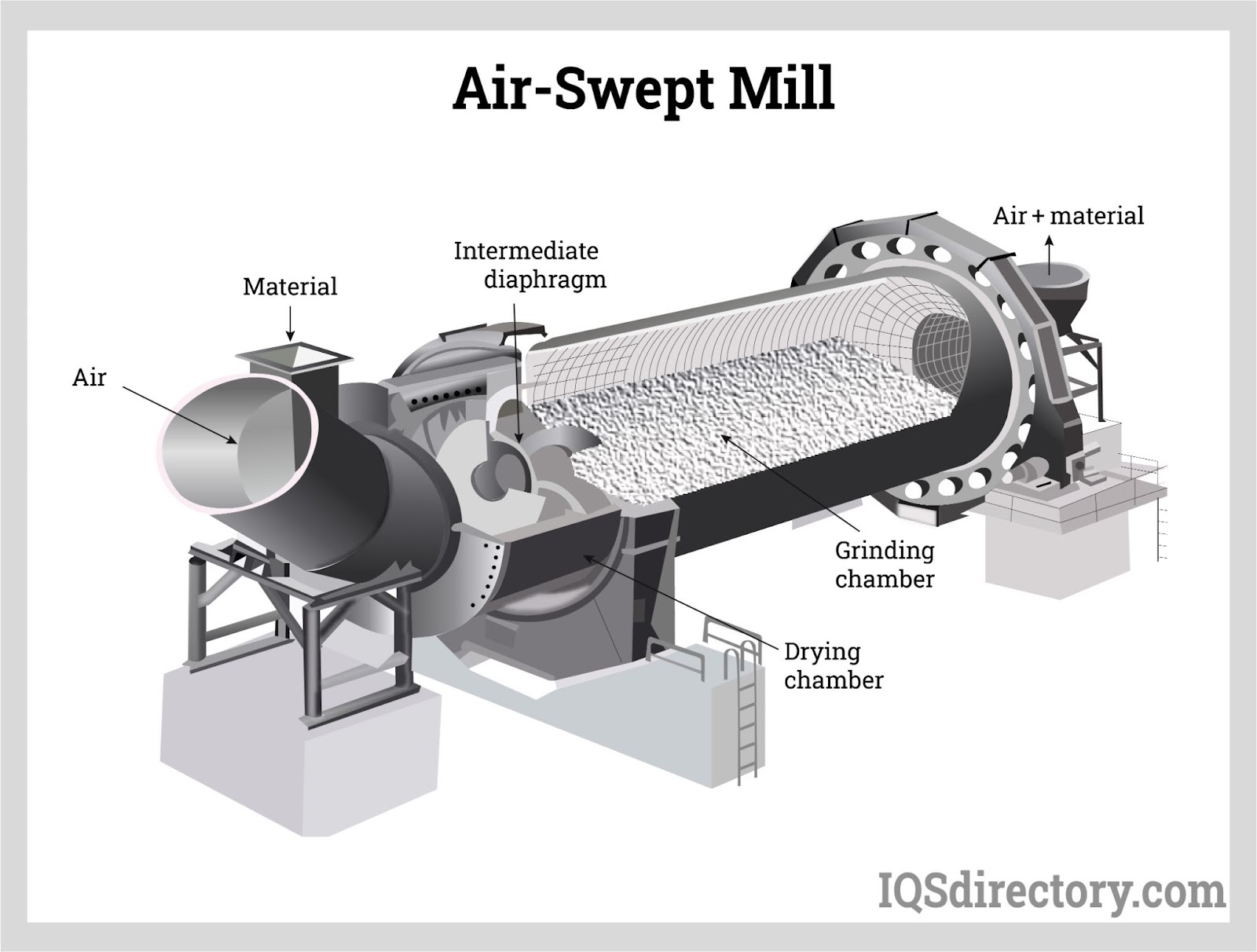
A mill is a mechanical device that is often a structure, appliance, or machine that is used to break down solid materials into smaller pieces by cutting, grinding, or crushing them. Many industrial processes involve...

A tank mixer is a mixing device that blends several different ingredients in a single tank to make a single solution. It is a mixing process capable of mixing wettable powders, liquids, emulsifiable concentrates, and surfactants. They mix and blend...
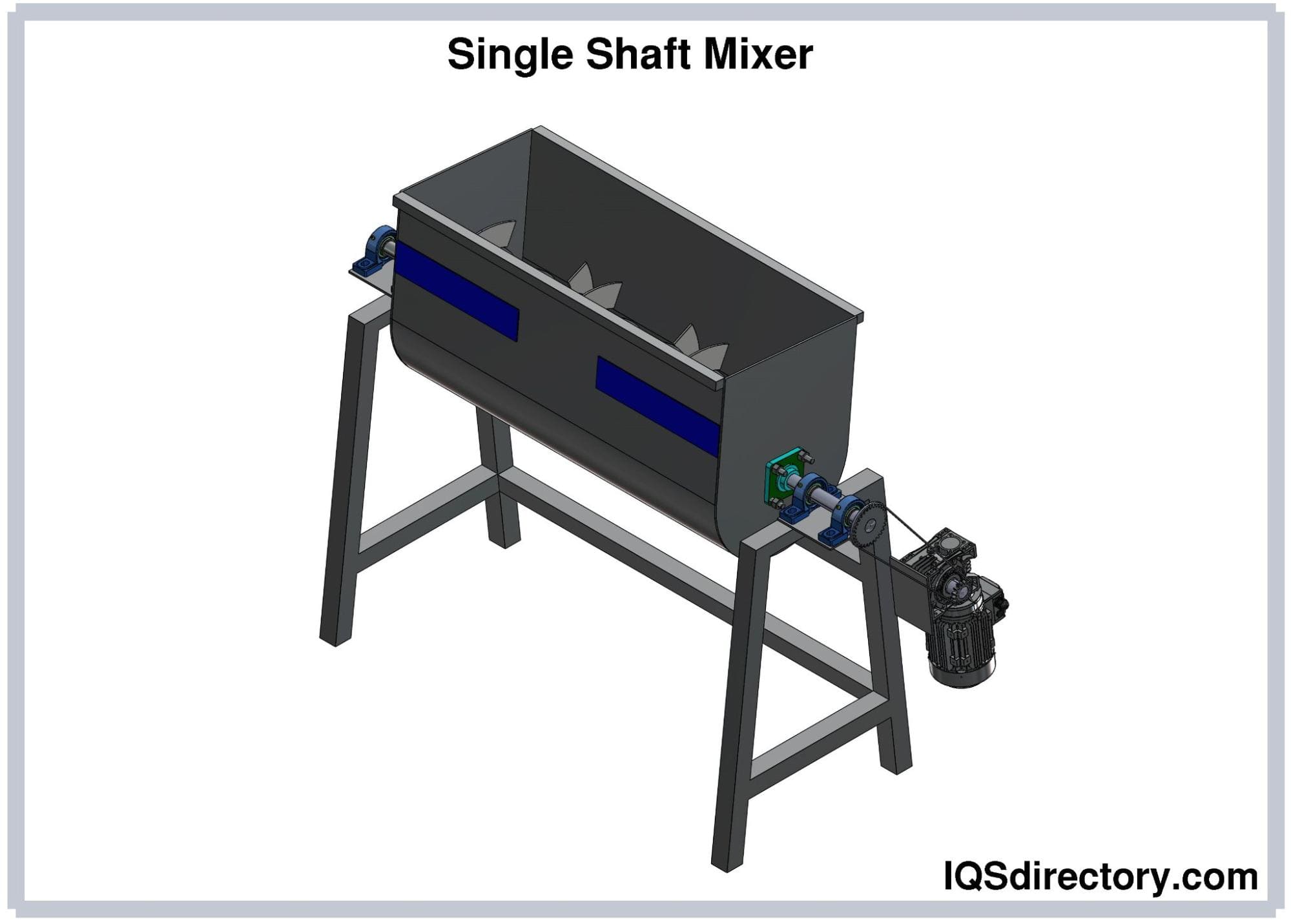
A mixer is a complex and precise tool that is used in combining and mixing of substances and chemicals for manufacturing, production, and industrial use. There are many types of industrial mixers including...
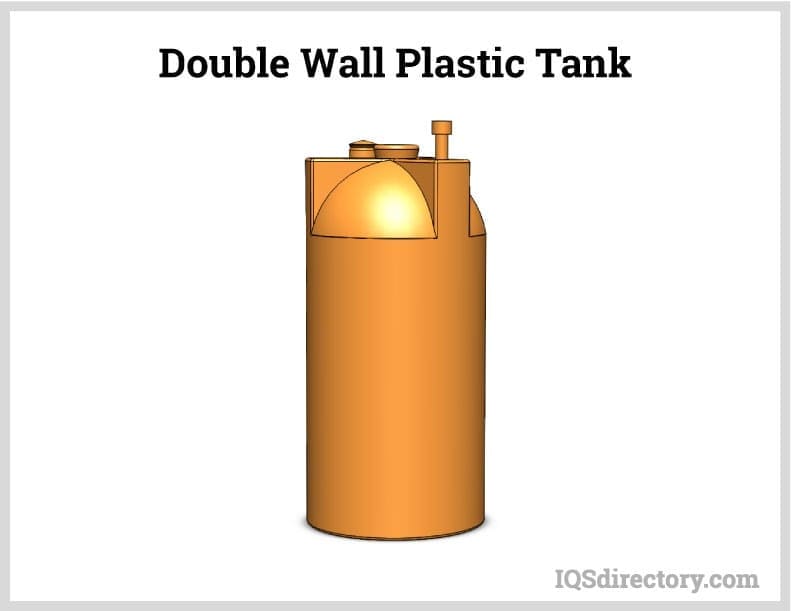
A plastic tank is a large capacity liquid or granular storage unit that can be vertical, horizontal, below or above ground, as well as movable. They are designed to hold several gallons of a variety of substances for long periods without experiencing wear, weathering, or deterioration...
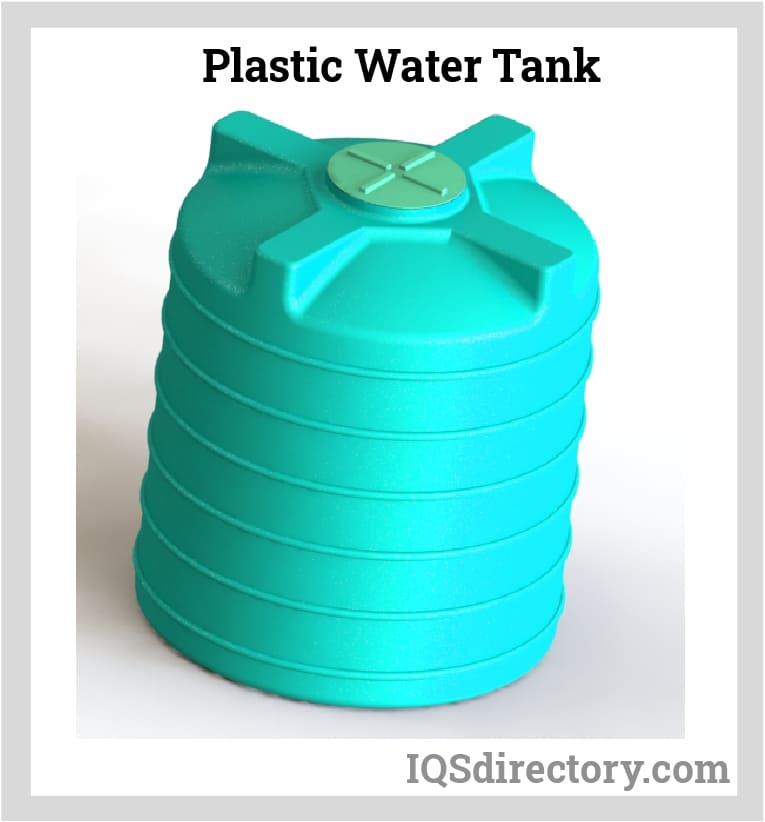
A plastic water tank is a large capacity container designed to store water for household, agricultural, irrigation, and industrial manufacturing use. There are various types of water tanks produced to meet the needs of specific applications, with...
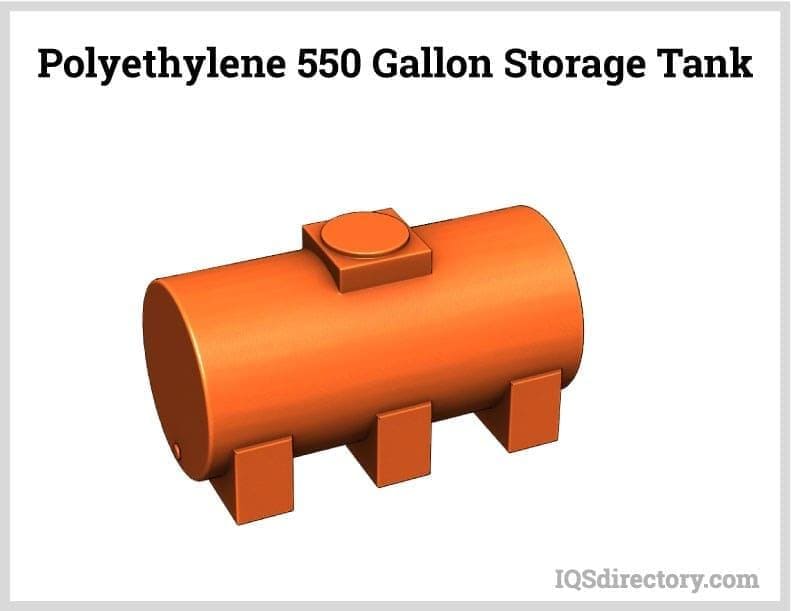
A poly tank is a plastic storage tank used to store, transport, and collect water, other liquids, and granular or powder materials. They are made of polyethylene or polypropylene and are a cost effective, lightweight, and easy to handle...
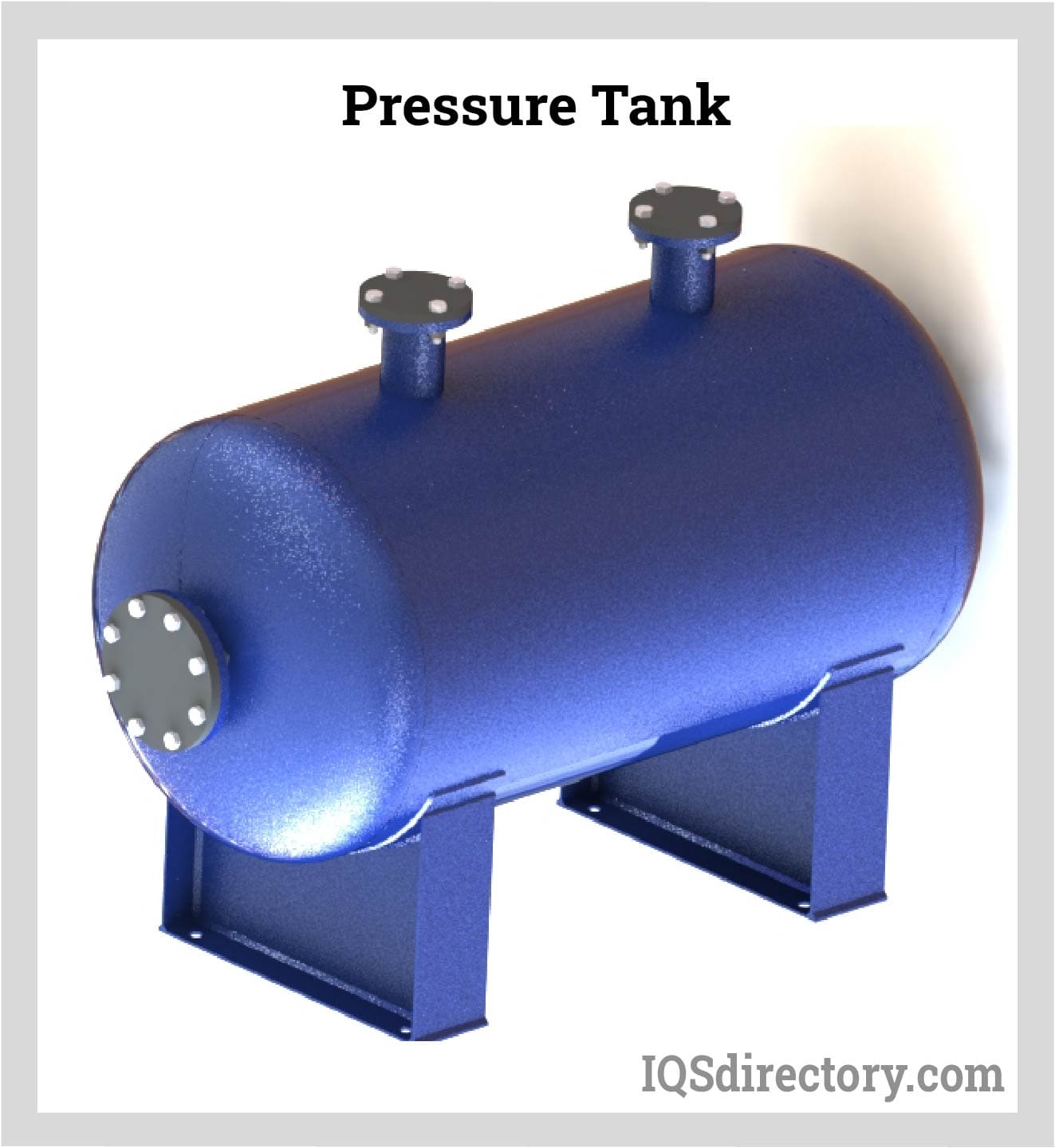
Pressure tanks are vessels that are used to store, hold, and/or convey gasses, vapors and fluids at pressures greater than atmospheric pressure, also known as high pressures...
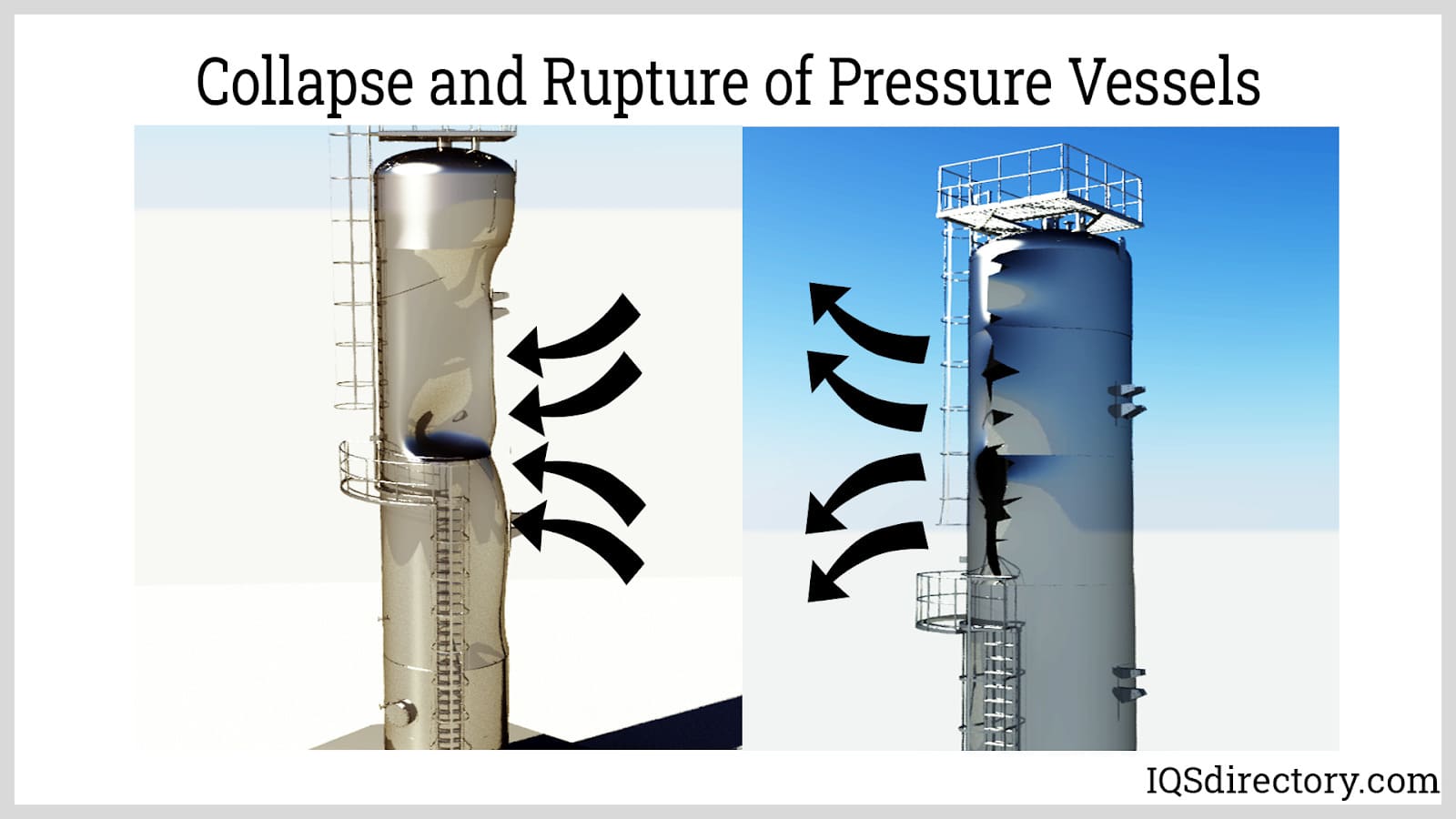
Pressure vessels are enclosed containers used to hold liquids, vapors, and gases at a pressure significantly higher or lower than the ambient pressure. They are widely used in various industries such as...
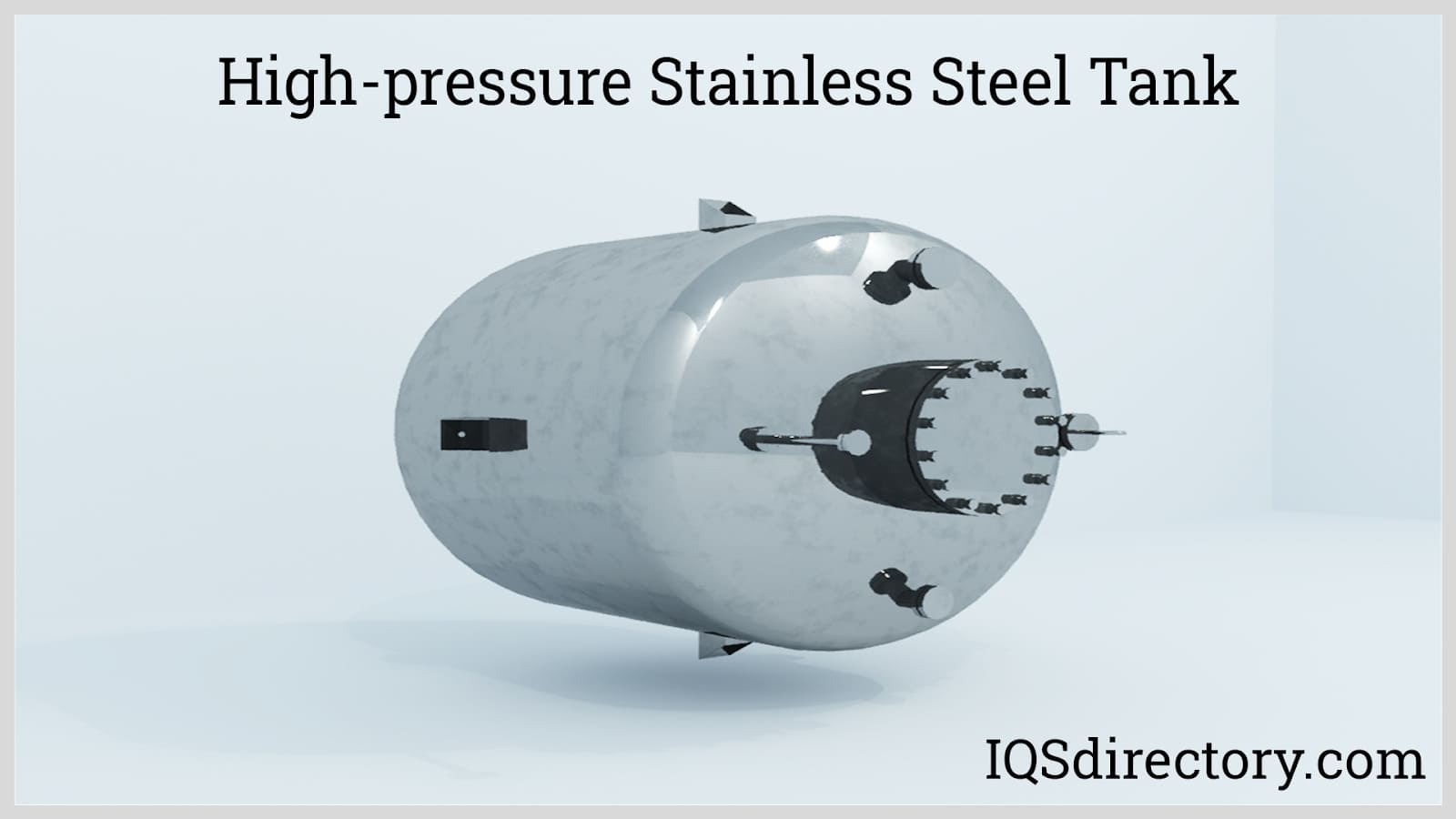
Stainless steel tanks are widely used in food, beverage, dairy, medicine, cosmetics, and other manufacturing processes where cleanliness and purity are important. These are also used in industrial plants for storing chemicals and gases where strong resistance from chemical degradation is required...